- Media Center
- E-Books & White Papers

An Overview of Market Research Future: Your Top Questions Answered
by Sarah Schmidt , on July 25, 2024

Over 1,000 syndicated reports by Market Research Future are available on MarketResearch.com. To help you better understand this publisher and their unique expertise, here are some answers to frequently asked questions about Market Research Future.
What is Market Research Future?
MRFR specializes in 13 industry verticals: Information & Communication Technology, Semiconductor & Electronics, Automotive, Healthcare, Energy and Power, Food and Beverages, Consumer and Fast-Moving Goods, Chemicals and Materials, Aerospace and Defense, Construction, and Agriculture sectors. The company offers syndicate research reports, custom research reports, and consulting projects.
Is Market Research Future legitimate?
Market Research Future is a legitimate company providing credible market information in its reports. MRFR is certified by the European Society for Opinion and Marketing Research (ESOMAR). MRFR procures data from purchased databases, SME journals, and pertinent databases from third-party vendors. About 80% of their research is based on primary data. The firm connects with more than 60% of companies in the market ecosystem to obtain details such as market trends, customer preferences, pain points, gaps, and market sizing from primary interviews and surveys. MRFR consultants and Key Opinion Leaders (KOLs), located in all prominent countries across the globe, help validate data and report insights before reports are published.
Where are the headquarters of Market Research Future?
Market Research Future is headquartered in Pune, India. The firm also has an office in New York, USA. Additionally, MRFR has consultants all over the globe to aid in client meetings and data gathering.
What type of information is provided in reports by this firm?
MRFR research reports provide qualitative and quantitative analysis. The quantitative analysis consists of market sizing data for historical years and forecasts for the next 8-10 years. The market sizing is provided by value (USD) and volume (units).
In the qualitative section of the report, MRFR provides market dynamics, market factor analysis, patent analysis, use-case scenarios, regulatory landscape, SWOT analysis, and PESTEL analysis. Reports also cover the impact of various macro environmental conditions at global or regional levels, such as COVID-19, the Russia-Ukraine war, the Israel-Palestine crisis, and many other factors.
In addition, the firm provides details on key market players, such as company overviews, financial information, market offerings, and business strategies. MRFR also provides key developments and a SWOT analysis of the market players. MRFR offers competitive benchmarking and a competitive dashboard where these companies are compared. The vendor share analysis of the leading players is also presented in the report.
What are some popular reports by Market Research Future?
- Electric Vehicle Charging Station Market
- Metaverse Market
Explore Market Research Future reports
Search MarketResearch.com to find all the latest reports by Market Research Future . On the publisher page, click the "refine your search" button to search for specific keywords or titles.
Need assistance? Get in touch with our research specialists , who are available to answer your questions and help you find what you need by this publisher or hundreds more.

About This Blog
Our goal is to help you better understand your customer, market, and competition in order to help drive your business growth.
Popular Posts
- A CEO’s Perspective on Harnessing AI for Market Research Excellence
- 7 Key Advantages of Outsourcing Market Research Services
- How to Use Market Research for Onboarding and Training Employees
- 10 Global Industries That Will Boom in the Next 5 Years
- Primary Data vs. Secondary Data: Market Research Methods
Recent Posts
Posts by topic.
- Industry Insights (845)
- Market Research Strategy (274)
- Food & Beverage (135)
- Healthcare (127)
- The Freedonia Group (121)
- How To's (110)
- Market Research Provider (98)
- Pharmaceuticals (83)
- Manufacturing & Construction (82)
- Packaged Facts (78)
- Telecommunications & Wireless (71)
- Heavy Industry (69)
- Retail (59)
- Marketing (58)
- Profound (57)
- Software & Enterprise Computing (57)
- Transportation & Shipping (54)
- House & Home (50)
- Materials & Chemicals (48)
- Medical Devices (47)
- Consumer Electronics (45)
- Energy & Resources (43)
- Public Sector (40)
- Biotechnology (38)
- Business Services & Administration (37)
- Demographics (37)
- Education (36)
- Custom Market Research (35)
- Diagnostics (34)
- E-commerce & IT Outsourcing (34)
- Academic (33)
- Travel & Leisure (33)
- Financial Services (29)
- Computer Hardware & Networking (28)
- Simba Information (24)
- Kalorama Information (21)
- Knowledge Centers (19)
- Apparel (18)
- Cosmetics & Personal Care (18)
- Market Research Subscription (16)
- Social Media (16)
- Advertising (14)
- Big Data (14)
- Holiday (11)
- Emerging Markets (8)
- Associations (1)
- Religion (1)
MarketResearch.com 6116 Executive Blvd Suite 550 Rockville, MD 20852 800.298.5699 (U.S.) +1.240.747.3093 (International) [email protected]
From Our Blog
Subscribe to blog, connect with us.

- Consumer Product
- Food & Beverage
- Chemicals and Materials
- Travel & Tourism
- Process Automation
- Industrial Automation
- Services & Utilities
- Testing Equipment
- Thought Leadership
Upcoming Reports
Published reports.
- Contact FMI
SMARTER WAY TO DO MARKET RESEARCH
Research Reports and Business Intelligence for Consistent Growth
Market Research Reports
Market Research Topics
3 Million +
Hours of Experience
Published market research reports that dig deep to uncover niche segments & hard-to-get insights
Pet Shampoo Market
Germany culinary tourism market, m2m services market, digital rights management market.
Browse industry's most comprehensive collection of upcoming market research reports
Blackcurrant Powder Market
Power line communication system market, fuel capacitance test equipment market, distributed cloud market, kids watch market, portable power station market, our business is to grow yours..
Join 500+ expert analysts to supercharge your growth
Redefining Youth: The Impact of Anti-Aging Supplements on Holistic Health

Certified Member

* Esomar is a business community of insights and analytics.
Recognized by

2023 ASIA - PACIFIC STEVIE AWARDS
Recognized for the Category:
Thought Leadership Campaign of the Year

Future Market Insights wins BRONZE STEVIE® in the 20th annual IBAs.
Recognized for:
Thought Leadership in Sustainable Packaging
Our Leadership Team
- Our team are craftspeople -

Research is a piece of art and not data
You are using an outdated browser. Please upgrade your browser to improve your experience.
Market Research All Publishers
Market Research Future
1,222 reports from market research future, refine your search, africa induction furnace market research report information by type (furnace, and channel induction furnace), by capacity (up to 1 ton, 1-100 tons, and more than 100 tons), by end use industry (steel, aluminum, copper, and others), by region (northern africa, central africa, southern africa, east africa, and western africa) industry forecast to 2032.
Aug 12, 2024 | Published by: Market Research Future | USD 2,950
Africa Induction Furnace Market Research Report Information by Type (Furnace, and Channel Induction Furnace), by Capacity (Up to 1 ton, 1-100 tons, and More Than 100 tons), by End Use Industry (Steel, Aluminum, Copper, and Others), by Region (Northern Africa, Central Africa, Southern Africa, East Af ... Read More
Absorbent Paper Market Research Report Forecast to 2032: America, Europe, and Asia-Pacific
Absorbent Paper Market Research Report Forecast to 2032: America, Europe, and Asia-Pacific It is anticipated that the absorbent paper market in the Americas, Europe, and Asia-Pacific will experience a robust growth rate of 5.1% during the review period. A form of porous paper that is specifically en ... Read More
Gaming Accessories Market Research Report By Product (Gamepads/ Joysticks/ Controllers, Gaming Keyboards, Gaming Mouse, Headsets, Surfaces, Virtual Reality (VR) Devices, Cooling Fans, Web Camera, and Others), by Device Type (PC (Desktop and Laptop), Smartphones and Gaming Consoles), by Distribution Channel (Online and Offline), by End Use (Casual Gaming and Professional Gaming) and By Region (North America, Europe, Asia-Pacific, Middle East and Africa, South America) – Global Forecast Till 2030
Aug 12, 2024 | Published by: Market Research Future | USD 4,950
Gaming Accessories Market Research Report By Product (Gamepads/ Joysticks/ Controllers, Gaming Keyboards, Gaming Mouse, Headsets, Surfaces, Virtual Reality (VR) Devices, Cooling Fans, Web Camera, and Others), by Device Type (PC (Desktop and Laptop), Smartphones and Gaming Consoles), by Distribution ... Read More
CNC metal cutting machine tools Market Research Report Information by Class (General, High End, and Special), by Tool (Metal Cutting and Metal Forming), by Product (5- Axis, 4- Axis, 3-Axis, 2-Axis, Others), by Machine Type (Conventional, Machining Centre, Turning Centre, Mill-Turn, and Others), by Application (Automotive, Machinery, IT & Electronics, Aerospace, Defense, Shipbuilding, Energy (e.g., Oil & Gas), Medical Devices, Construction, Precision Engineering, and Others), and by Region (North America, Europe, Asia Pacific, Middle East & Africa)- Industry Forecast to 2032
CNC metal cutting machine tools Market Research Report Information by Class (General, High End, and Special), by Tool (Metal Cutting and Metal Forming), by Product (5- Axis, 4- Axis, 3-Axis, 2-Axis, Others), by Machine Type (Conventional, Machining Centre, Turning Centre, Mill-Turn, and Others), by ... Read More
Sourdough Market Research Report Information By Product Type (Type I, Type II, And Type III), By Form (Dry, and Liquid), By Source (Wheat, Rye, Oats, and Barley), By Category (Organic, and Regular), By Application (Bread Products, Pizza & Pizza Crust, Cakes & Pies, and Others), By Distribution Channel (Store-Based and Non-Store-Based) and By Region (North America, Europe, Asia-Pacific, and Rest of the World) – Industry Forecast Till 2032
Sourdough Market Research Report Information By Product Type (Type I, Type II, And Type III), By Form (Dry, and Liquid), By Source (Wheat, Rye, Oats, and Barley), By Category (Organic, and Regular), By Application (Bread Products, Pizza & Pizza Crust, Cakes & Pies, and Others), By Distribution Chann ... Read More
Outdoor and Ski Sportswear Market Research Report Information By Type (Jackets, Top Wear, Bottom Wear, Footwear, Accessories, and Others), Sport Type (Skiing, Outdoor), By End User (Men, Women, and Unisex), By Price Range (Economy/Mass, Premium), By Distribution Channel (Supermarkets & Hypermarkets, Specialty Stores, and Online) And By Region (North America, Europe, Asia-Pacific, Middle East and Africa , and South America) – Industry Forecast Till 2032
Outdoor and Ski Sportswear Market Research Report Information By Type (Jackets, Top Wear, Bottom Wear, Footwear, Accessories, and Others), Sport Type (Skiing, Outdoor), By End User (Men, Women, and Unisex), By Price Range (Economy/Mass, Premium), By Distribution Channel (Supermarkets & Hypermarkets, ... Read More
North America and Europe Ready Meals Market Research Information By Source {Legumes (Beans, Chickpeas, Peas and Others), Grain (Oats, Wheat, Corn, Rice and Others)}, by Category (Ready to Eat and Ready to Cook), by Nature (Organic and Conventional), by End User (Residential and Commercial), by Distribution Channel {Store-Based (Supermarkets & Hypermarkets, Specialty Stores, Convenience Store), Non-Store Based (E-Commerce and Company Based Website)} Industry Forecast to 2032
North America and Europe Ready Meals Market Research Information By Source {Legumes (Beans, Chickpeas, Peas and Others), Grain (Oats, Wheat, Corn, Rice and Others)}, by Category (Ready to Eat and Ready to Cook), by Nature (Organic and Conventional), by End User (Residential and Commercial), by Distr ... Read More
Asia-Pacific Crushing, Screening and Mineral Processing Equipment Market Research Report Information By equipment type (Crushing Equipment, Screening Equipment and Mineral Processing equipment) By mobility (Stationary and Mobile), Power Source (Diesel, Electric and Hybrid), application (Construction, Mining, agriculture, Foundries and Others) and By Region – Industry Forecast to 2030
Asia-Pacific Crushing, Screening and Mineral Processing Equipment Market Research Report Information By equipment type (Crushing Equipment, Screening Equipment and Mineral Processing equipment) By mobility (Stationary and Mobile), Power Source (Diesel, Electric and Hybrid), application (Construction ... Read More
Europe Bearing Market Research Report Information by Type (Plain Bearing, Ball Bearing, Roller Bearing, Linear Bearing, Fluid Bearing, and Other), by Material (Steel, Ceramic, Polymer Plastic, and Hybrid), by Application (Automotive, Aerospace & Defense, Construction, Food & Beverage, Chemical, and Others), by Sales channel (OEM and MRO) - Industry Forecast to 2032
Europe Bearing Market Research Report Information by Type (Plain Bearing, Ball Bearing, Roller Bearing, Linear Bearing, Fluid Bearing, and Other), by Material (Steel, Ceramic, Polymer Plastic, and Hybrid), by Application (Automotive, Aerospace & Defense, Construction, Food & Beverage, Chemical, and ... Read More
Europe Pillow Market Research Report Data By Product Type (Feather Pillows, Down Pillows, Memory Foam Pillows, Latex Pillows, Synthetic Pillows, and Others), By Type (Adjustable Pillows and Non-Adjustable Pillows), By Design (Ergonomic Pillows and Normal Pillows), By Pillow Sizes (Standard, Super-Standard, Queen, King, European, and Others), By Category (Smart Pillows and Standard Pillows), By Nature (Eco-Friendly Pillows and Regular), By Distribution Channel (Supermarket & Hypermarket, Specialty Store, Online and Others), and By Country- Industry Forecast to 2032
Europe Pillow Market Research Report Data By Product Type (Feather Pillows, Down Pillows, Memory Foam Pillows, Latex Pillows, Synthetic Pillows, and Others), By Type (Adjustable Pillows and Non-Adjustable Pillows), By Design (Ergonomic Pillows and Normal Pillows), By Pillow Sizes (Standard, Super-St ... Read More
Engine PMA Parts and DER Repair Market Research Report By Type (PMA Parts and DER Repair), By Parts Type (Combustion, Turbine, Compressor, Fuel System, Exhaust System, Thrust Reverser, and Others), By Engine Type (CFM56-5B, CFM56-7B, GE90, V2500, CF6, CF34, PW2000, PW4000, JT8D, JT9D, and Others), By End User (Commercial Aviation and General & Business Aviation), and By Region (North America, Europe, Asia-Pacific, Middle East & Africa, and Latin America) Industry Forecast Till 2032
Engine PMA Parts and DER Repair Market Research Report By Type (PMA Parts and DER Repair), By Parts Type (Combustion, Turbine, Compressor, Fuel System, Exhaust System, Thrust Reverser, and Others), By Engine Type (CFM56-5B, CFM56-7B, GE90, V2500, CF6, CF34, PW2000, PW4000, JT8D, JT9D, and Others), B ... Read More
Distributed Fiber Optic Sensor Market Research Report Data Analysis By Type (OTDR, OFDR), By Scattering Method (Raman Scattering Effect, Rayleigh Scattering Effect, Brillouin Scattering Effect, Fiber Brag Grating), By Application (Temperature Sensing, Acoustic Sensing, Strain Sensing), By Industry Application (Oil & Gas, Power And Utility, Safety And Security, Infrastructure, Industrial, Telecommunication, Others), And By Region (North America, Europe, Asia-Pacific, Middle East & Africa, and South America) – Forecast Till 2030
Distributed Fiber Optic Sensor Market Research Report Data Analysis By Type (OTDR, OFDR), By Scattering Method (Raman Scattering Effect, Rayleigh Scattering Effect, Brillouin Scattering Effect, Fiber Brag Grating), By Application (Temperature Sensing, Acoustic Sensing, Strain Sensing), By Industry A ... Read More
Gum Arabic Market Research Report Information By Nature (Organic and Conventional), Functional Properties (Emulsifier, Stabilizer, and Thickener), By Grade (Acacia senegal and Acacia seyal), By Form (Kibbled Acacia Gum, Powdered Acacia Gum, Raw Gum Arabic, and Spray-Dried Acacia Gum), By Application (Food and Beverages, Pharmaceuticals, Nutraceuticals, Cosmetics and Personal Care, Paints and Coating, and Other Applications) And By Region (North America, Europe, Asia-Pacific, and Rest of the World) – Industry Forecast Till 2032
Gum Arabic Market Research Report Information By Nature (Organic and Conventional), Functional Properties (Emulsifier, Stabilizer, and Thickener), By Grade (Acacia senegal and Acacia seyal), By Form (Kibbled Acacia Gum, Powdered Acacia Gum, Raw Gum Arabic, and Spray-Dried Acacia Gum), By Application ... Read More
Commercial HVAC Market Research Report Information by Equipment (Cooling Equipment, Heating Equipment, Ventilation Equipment) by sales channel (OEM, Aftermaths), by components ( sensors, compressors, control systems, expansion valves, evaporator coils, ventilation fan and blower units, filters, dampers, tubing/piping systems, and others), by Application (office, school & colleges, restaurants, hotels, shops, apartment, hospitals & clinics, sport centers, data center/ server hub, warehouses, factories),–Industry Forecast Till 2030
Commercial HVAC Market Research Report Information by Equipment (Cooling Equipment, Heating Equipment, Ventilation Equipment) by sales channel (OEM, Aftermaths), by components ( sensors, compressors, control systems, expansion valves, evaporator coils, ventilation fan and blower units, filters, damp ... Read More
Electric Cargo Bike Market Research Report By Product Type (Two-Wheeler, Three-Wheeler, Four-Wheeler), By Battery Type (Li-ion ,Lead Based ,Nickel Based),By Drive Type(1WD ,2WD, 4WD),By Model Type(Box Model ,Pick Up Model), By Range (Up to 50 Km, More than 50 Km) ,By Top Speed(Up to 25 Km/H, More than 25 Km/H),By Payload(Up to 100 Kg, More than 100 Kg),By Application (Commuting, Shopping and Errands, Delivery and Logistics, Heavy-Duty), By Region (North America, Europe, Asia-Pacific, Middle East and Africa, South America) – Industry Forecast T0 2032
Aug 02, 2024 | Published by: Market Research Future | USD 4,950
Electric Cargo Bike Market Research Report By Product Type (Two-Wheeler, Three-Wheeler, Four-Wheeler), By Battery Type (Li-ion ,Lead Based ,Nickel Based),By Drive Type(1WD ,2WD, 4WD),By Model Type(Box Model ,Pick Up Model), By Range (Up to 50 Km, More than 50 Km) ,By Top Speed(Up to 25 Km/H, More th ... Read More
Craft Brewery Equipment Market
Brewery Equipment Market Research Report Information By Type (Brew House Equipment, Fermentation Equipment, Control & Monitoring, Filling & Packaging, and Others), Price Range (Economy/Mass, and Premium), By Material (Brass, Copper, Aluminum, Stainless Steel, Mild Steel), By Mode of Operation (Autom ... Read More
Task Management & Business Process Management Software Market Research Report By Component(Software{Task Management software and Business Process Management (BPM)} ,Services{Integration & Implementation, Consulting ,Training& Support), By Organization Size(Small & Medium-Sized Enterprises (SMES),Large Enterprises), By Deployment (On-Premises ,Cloud),By Industry Verticals (Banking, Financial Services, & Insurance (BFSI), Retail & Consumer Goods, Healthcare, IT & Telecom, Government, Real Estate & Construction, Travel& Hospitality, Media & Entertainment), by Region- Industry Forecast to 2032
Task Management & Business Process Management Software Market Research Report By Component(Software{Task Management software and Business Process Management (BPM)} ,Services{Integration & Implementation, Consulting ,Training& Support), By Organization Size(Small & Medium-Sized Enterprises (SMES),Lar ... Read More
India Host Cell Protein Testing Market Research Report Information by Product Type (PCR-based assays, ELISA-based assays, mass spectrometry-based assays and others), by End User (Contract Research Organizations, Biopharmaceutical Companies, and Others) – Industry Forecast to 2032
Aug 02, 2024 | Published by: Market Research Future | USD 2,950
India Host Cell Protein Testing Market Research Report Information by Product Type (PCR-based assays, ELISA-based assays, mass spectrometry-based assays and others), by End User (Contract Research Organizations, Biopharmaceutical Companies, and Others) – Industry Forecast to 2032 It is projected tha ... Read More
APAC, MENA, and African sickle cell anemia markets research report Data By End User (Hospitals, Specialty Clinics, and Others), by Treatment (Pharmaceutics, Blood Transfusion, Bone Marrow Transplant, and Gene Therapy), by Region Forecast to 2032
APAC, MENA, and African sickle cell anemia markets research report Data By End User (Hospitals, Specialty Clinics, and Others), by Treatment (Pharmaceutics, Blood Transfusion, Bone Marrow Transplant, and Gene Therapy), by Region Forecast to 2032 The sickle cell anemia market in APAC, MENA, and Afric ... Read More
Certified Gemstones Market Research Report Information By Gemstones Type (Emerald, Pearl, Ruby, Sapphire, Other Gemstones), Category (Natural, Synthetic), By Distribution Channel (Store, Non-Store), By End-Users (Jewelry and Ornaments, Luxury Arts) And By Region (North America, Europe, Asia-Pacific, and Middle East and Africa, South America) – Industry Forecast Till 2032
Certified Gemstones Market Research Report Information By Gemstones Type (Emerald, Pearl, Ruby, Sapphire, Other Gemstones), Category (Natural, Synthetic), By Distribution Channel (Store, Non-Store), By End-Users (Jewelry and Ornaments, Luxury Arts) And By Region (North America, Europe, Asia-Pacific, ... Read More
Automotive Comfort and Closure Motors and Actuators Market Research Report By Offering (Motors{Brushless DC Motors ,Brush Motors ,Stepper Motors}, Actuator), By Application (Seating Actuation {Recliner, Height Adjustment, Tilt ,Track Adjustment}, Power Liftgate (PLG) ,Seat Latch ,Sunroof, Frunk ,Power Windows, Others), By Vehicle Propulsion (ICE vehicles , EV (Electric Vehicles), By Vehicle Type(Passenger Cars ,Commercial Vehicles { LCVs, Trucks ,Buses}, Off-Highway Vehicles) ,By Sales Channel (OEM and Aftermarket) and By Region – Industry Forecast to 2032
Automotive Comfort and Closure Motors and Actuators Market Research Report By Offering (Motors{Brushless DC Motors ,Brush Motors ,Stepper Motors}, Actuator), By Application (Seating Actuation {Recliner, Height Adjustment, Tilt ,Track Adjustment}, Power Liftgate (PLG) ,Seat Latch ,Sunroof, Frunk ,Pow ... Read More
Full-Face Military Gas Mask Market Research Report By Product Type (Air-Purifying Respirators and Powered Air Purifying Respirators), by Size (Large, Medium & Small), by End Use (Male Military Personnel and Female Military Personnel), and By Region (North America, Europe, Asia-Pacific, Middle East and Africa, South America) –Industry Forecast Till 2032
Full-Face Military Gas Mask Market Research Report By Product Type (Air-Purifying Respirators and Powered Air Purifying Respirators), by Size (Large, Medium & Small), by End Use (Male Military Personnel and Female Military Personnel), and By Region (North America, Europe, Asia-Pacific, Middle East a ... Read More
Geospatial Market Research Report Information by Type (Surface Analytics, Network Analytics, Geovisualization, Others), By Technology (Remote Sensing, GPS, GIS, Others), By End-User (Real Estate & Construction, Automotive, Utility & Communication, Government, Defense & Intelligence, Natural Resources, Others), And By Region (North America, Europe, Asia-Pacific, Middle East & Africa and South America) – Industry Forecast Till 2032
Geospatial Market Research Report Information by Type (Surface Analytics, Network Analytics, Geovisualization, Others), By Technology (Remote Sensing, GPS, GIS, Others), By End-User (Real Estate & Construction, Automotive, Utility & Communication, Government, Defense & Intelligence, Natural Resource ... Read More
Frozen Pizza Market Research Report Information By Distribution Channel (Store-Based, Non-Store Based), Category (Gluten Free), By Crust Type (Thin, Pan, Stuffed Crust, and Others), By Size (Regular, Medium, Large), By Region (North America, Europe, Asia-Pacific, South America, and Middle East and Africa) – Industry Forecast Till 2032
Frozen Pizza Market Research Report Information By Distribution Channel (Store-Based, Non-Store Based), Category (Gluten Free), By Crust Type (Thin, Pan, Stuffed Crust, and Others), By Size (Regular, Medium, Large), By Region (North America, Europe, Asia-Pacific, South America, and Middle East and A ... Read More
DC-DC Converter Market Research Report Data By Form Factor (Chassis, Chassis Mount, DIN Rail, PCB Mount, Rack, SMD/SMT and Through Hole), by Input Voltage (<12v, 9-36v, 18-75v, 40-160v and >200v), by Output Voltage (<2v, 3.3v, 5v, 12v, 15v, 24v and >24v), by Output Power (0-100W, 101-250W, 251W-500W, 500-1000W and >1000W), by Output Number (Single, Dual, Triple and Multiple), by Product Type (Isolated DC-DC Converter and Non-Isolated DC-DC Converter), By Isolation Working Voltage (50-150V, 150-250V, 200-1000V, 1000-2500V, >2500V- Industry Forecast to 2032
Jul 25, 2024 | Published by: Market Research Future | USD 4,950
DC-DC Converter Market Research Report Data By Form Factor (Chassis, Chassis Mount, DIN Rail, PCB Mount, Rack, SMD/SMT and Through Hole), by Input Voltage ( 200v), by Output Voltage (<2v, 3.3v, 5v, 12v, 15v, 24v and <24v), by Output Power (0-100W, 101-250W, 251W-500W, 500-1000W and >1000W), by ... Read More
< prev 1 2 3 4 5 6 7 8 9 10 next >
Matching Categories
- Manufacturing & Construction (352)
- Materials & Chemicals (255)
- Transportation & Shipping (226)
- Energy & Resources (208)
- Consumer Goods & Retailing (187)
- Pharmaceuticals (144)
- Computer Hardware & Networking (126)
- Software & Enterprise Computing (94)
- Medical Devices (69)
- Telecommunications & Wireless (63)
- Healthcare (52)
- Beverages (46)
- Biotechnology (38)
- Diagnostics (34)
- Travel & Leisure (27)
- Agriculture (25)
- Defense (25)
- Financial Services (23)
- E-Commerce & IT Outsourcing (16)
- Business Services & Administration (15)
- Food Service & Hospitality (13)
- Demographics (8)
- Advertising & Marketing (5)
- Government (5)
- Education (3)
Research Assistance

Join Alert Me Now!

Download our eBook: How to Succeed Using Market Research
Learn how to effectively navigate the market research process to help guide your organization on the journey to success.
How to Do Market Research: The Complete Guide
Learn how to do market research with this step-by-step guide, complete with templates, tools and real-world examples.
Access best-in-class company data
Get trusted first-party funding data, revenue data and firmographics
Market research is the systematic process of gathering, analyzing and interpreting information about a specific market or industry.
What are your customers’ needs? How does your product compare to the competition? What are the emerging trends and opportunities in your industry? If these questions keep you up at night, it’s time to conduct market research.
Market research plays a pivotal role in your ability to stay competitive and relevant, helping you anticipate shifts in consumer behavior and industry dynamics. It involves gathering these insights using a wide range of techniques, from surveys and interviews to data analysis and observational studies.
In this guide, we’ll explore why market research is crucial, the various types of market research, the methods used in data collection, and how to effectively conduct market research to drive informed decision-making and success.
What is market research?
The purpose of market research is to offer valuable insight into the preferences and behaviors of your target audience, and anticipate shifts in market trends and the competitive landscape. This information helps you make data-driven decisions, develop effective strategies for your business, and maximize your chances of long-term growth.

Why is market research important?
By understanding the significance of market research, you can make sure you’re asking the right questions and using the process to your advantage. Some of the benefits of market research include:
- Informed decision-making: Market research provides you with the data and insights you need to make smart decisions for your business. It helps you identify opportunities, assess risks and tailor your strategies to meet the demands of the market. Without market research, decisions are often based on assumptions or guesswork, leading to costly mistakes.
- Customer-centric approach: A cornerstone of market research involves developing a deep understanding of customer needs and preferences. This gives you valuable insights into your target audience, helping you develop products, services and marketing campaigns that resonate with your customers.
- Competitive advantage: By conducting market research, you’ll gain a competitive edge. You’ll be able to identify gaps in the market, analyze competitor strengths and weaknesses, and position your business strategically. This enables you to create unique value propositions, differentiate yourself from competitors, and seize opportunities that others may overlook.
- Risk mitigation: Market research helps you anticipate market shifts and potential challenges. By identifying threats early, you can proactively adjust their strategies to mitigate risks and respond effectively to changing circumstances. This proactive approach is particularly valuable in volatile industries.
- Resource optimization: Conducting market research allows organizations to allocate their time, money and resources more efficiently. It ensures that investments are made in areas with the highest potential return on investment, reducing wasted resources and improving overall business performance.
- Adaptation to market trends: Markets evolve rapidly, driven by technological advancements, cultural shifts and changing consumer attitudes. Market research ensures that you stay ahead of these trends and adapt your offerings accordingly so you can avoid becoming obsolete.
As you can see, market research empowers businesses to make data-driven decisions, cater to customer needs, outperform competitors, mitigate risks, optimize resources and stay agile in a dynamic marketplace. These benefits make it a huge industry; the global market research services market is expected to grow from $76.37 billion in 2021 to $108.57 billion in 2026 . Now, let’s dig into the different types of market research that can help you achieve these benefits.
Types of market research
- Qualitative research
- Quantitative research
- Exploratory research
- Descriptive research
- Causal research
- Cross-sectional research
- Longitudinal research
Despite its advantages, 23% of organizations don’t have a clear market research strategy. Part of developing a strategy involves choosing the right type of market research for your business goals. The most commonly used approaches include:
1. Qualitative research
Qualitative research focuses on understanding the underlying motivations, attitudes and perceptions of individuals or groups. It is typically conducted through techniques like in-depth interviews, focus groups and content analysis — methods we’ll discuss further in the sections below. Qualitative research provides rich, nuanced insights that can inform product development, marketing strategies and brand positioning.
2. Quantitative research
Quantitative research, in contrast to qualitative research, involves the collection and analysis of numerical data, often through surveys, experiments and structured questionnaires. This approach allows for statistical analysis and the measurement of trends, making it suitable for large-scale market studies and hypothesis testing. While it’s worthwhile using a mix of qualitative and quantitative research, most businesses prioritize the latter because it is scientific, measurable and easily replicated across different experiments.
3. Exploratory research
Whether you’re conducting qualitative or quantitative research or a mix of both, exploratory research is often the first step. Its primary goal is to help you understand a market or problem so you can gain insights and identify potential issues or opportunities. This type of market research is less structured and is typically conducted through open-ended interviews, focus groups or secondary data analysis. Exploratory research is valuable when entering new markets or exploring new product ideas.
4. Descriptive research
As its name implies, descriptive research seeks to describe a market, population or phenomenon in detail. It involves collecting and summarizing data to answer questions about audience demographics and behaviors, market size, and current trends. Surveys, observational studies and content analysis are common methods used in descriptive research.
5. Causal research
Causal research aims to establish cause-and-effect relationships between variables. It investigates whether changes in one variable result in changes in another. Experimental designs, A/B testing and regression analysis are common causal research methods. This sheds light on how specific marketing strategies or product changes impact consumer behavior.
6. Cross-sectional research
Cross-sectional market research involves collecting data from a sample of the population at a single point in time. It is used to analyze differences, relationships or trends among various groups within a population. Cross-sectional studies are helpful for market segmentation, identifying target audiences and assessing market trends at a specific moment.
7. Longitudinal research
Longitudinal research, in contrast to cross-sectional research, collects data from the same subjects over an extended period. This allows for the analysis of trends, changes and developments over time. Longitudinal studies are useful for tracking long-term developments in consumer preferences, brand loyalty and market dynamics.
Each type of market research has its strengths and weaknesses, and the method you choose depends on your specific research goals and the depth of understanding you’re aiming to achieve. In the following sections, we’ll delve into primary and secondary research approaches and specific research methods.
Primary vs. secondary market research
Market research of all types can be broadly categorized into two main approaches: primary research and secondary research. By understanding the differences between these approaches, you can better determine the most appropriate research method for your specific goals.
Primary market research
Primary research involves the collection of original data straight from the source. Typically, this involves communicating directly with your target audience — through surveys, interviews, focus groups and more — to gather information. Here are some key attributes of primary market research:
- Customized data: Primary research provides data that is tailored to your research needs. You design a custom research study and gather information specific to your goals.
- Up-to-date insights: Because primary research involves communicating with customers, the data you collect reflects the most current market conditions and consumer behaviors.
- Time-consuming and resource-intensive: Despite its advantages, primary research can be labor-intensive and costly, especially when dealing with large sample sizes or complex study designs. Whether you hire a market research consultant, agency or use an in-house team, primary research studies consume a large amount of resources and time.
Secondary market research
Secondary research, on the other hand, involves analyzing data that has already been compiled by third-party sources, such as online research tools, databases, news sites, industry reports and academic studies.

Here are the main characteristics of secondary market research:
- Cost-effective: Secondary research is generally more cost-effective than primary research since it doesn’t require building a research plan from scratch. You and your team can look at databases, websites and publications on an ongoing basis, without needing to design a custom experiment or hire a consultant.
- Leverages multiple sources: Data tools and software extract data from multiple places across the web, and then consolidate that information within a single platform. This means you’ll get a greater amount of data and a wider scope from secondary research.
- Quick to access: You can access a wide range of information rapidly — often in seconds — if you’re using online research tools and databases. Because of this, you can act on insights sooner, rather than taking the time to develop an experiment.
So, when should you use primary vs. secondary research? In practice, many market research projects incorporate both primary and secondary research to take advantage of the strengths of each approach.
One rule of thumb is to focus on secondary research to obtain background information, market trends or industry benchmarks. It is especially valuable for conducting preliminary research, competitor analysis, or when time and budget constraints are tight. Then, if you still have knowledge gaps or need to answer specific questions unique to your business model, use primary research to create a custom experiment.
Market research methods
- Surveys and questionnaires
- Focus groups
- Observational research
- Online research tools
- Experiments
- Content analysis
- Ethnographic research
How do primary and secondary research approaches translate into specific research methods? Let’s take a look at the different ways you can gather data:
1. Surveys and questionnaires
Surveys and questionnaires are popular methods for collecting structured data from a large number of respondents. They involve a set of predetermined questions that participants answer. Surveys can be conducted through various channels, including online tools, telephone interviews and in-person or online questionnaires. They are useful for gathering quantitative data and assessing customer demographics, opinions, preferences and needs. On average, customer surveys have a 33% response rate , so keep that in mind as you consider your sample size.
2. Interviews
Interviews are in-depth conversations with individuals or groups to gather qualitative insights. They can be structured (with predefined questions) or unstructured (with open-ended discussions). Interviews are valuable for exploring complex topics, uncovering motivations and obtaining detailed feedback.
3. Focus groups
The most common primary research methods are in-depth webcam interviews and focus groups. Focus groups are a small gathering of participants who discuss a specific topic or product under the guidance of a moderator. These discussions are valuable for primary market research because they reveal insights into consumer attitudes, perceptions and emotions. Focus groups are especially useful for idea generation, concept testing and understanding group dynamics within your target audience.
4. Observational research
Observational research involves observing and recording participant behavior in a natural setting. This method is particularly valuable when studying consumer behavior in physical spaces, such as retail stores or public places. In some types of observational research, participants are aware you’re watching them; in other cases, you discreetly watch consumers without their knowledge, as they use your product. Either way, observational research provides firsthand insights into how people interact with products or environments.
5. Online research tools
You and your team can do your own secondary market research using online tools. These tools include data prospecting platforms and databases, as well as online surveys, social media listening, web analytics and sentiment analysis platforms. They help you gather data from online sources, monitor industry trends, track competitors, understand consumer preferences and keep tabs on online behavior. We’ll talk more about choosing the right market research tools in the sections that follow.
6. Experiments
Market research experiments are controlled tests of variables to determine causal relationships. While experiments are often associated with scientific research, they are also used in market research to assess the impact of specific marketing strategies, product features, or pricing and packaging changes.
7. Content analysis
Content analysis involves the systematic examination of textual, visual or audio content to identify patterns, themes and trends. It’s commonly applied to customer reviews, social media posts and other forms of online content to analyze consumer opinions and sentiments.
8. Ethnographic research
Ethnographic research immerses researchers into the daily lives of consumers to understand their behavior and culture. This method is particularly valuable when studying niche markets or exploring the cultural context of consumer choices.
How to do market research
- Set clear objectives
- Identify your target audience
- Choose your research methods
- Use the right market research tools
- Collect data
- Analyze data
- Interpret your findings
- Identify opportunities and challenges
- Make informed business decisions
- Monitor and adapt
Now that you have gained insights into the various market research methods at your disposal, let’s delve into the practical aspects of how to conduct market research effectively. Here’s a quick step-by-step overview, from defining objectives to monitoring market shifts.
1. Set clear objectives
When you set clear and specific goals, you’re essentially creating a compass to guide your research questions and methodology. Start by precisely defining what you want to achieve. Are you launching a new product and want to understand its viability in the market? Are you evaluating customer satisfaction with a product redesign?
Start by creating SMART goals — objectives that are specific, measurable, achievable, relevant and time-bound. Not only will this clarify your research focus from the outset, but it will also help you track progress and benchmark your success throughout the process.
You should also consult with key stakeholders and team members to ensure alignment on your research objectives before diving into data collecting. This will help you gain diverse perspectives and insights that will shape your research approach.
2. Identify your target audience
Next, you’ll need to pinpoint your target audience to determine who should be included in your research. Begin by creating detailed buyer personas or stakeholder profiles. Consider demographic factors like age, gender, income and location, but also delve into psychographics, such as interests, values and pain points.
The more specific your target audience, the more accurate and actionable your research will be. Additionally, segment your audience if your research objectives involve studying different groups, such as current customers and potential leads.
If you already have existing customers, you can also hold conversations with them to better understand your target market. From there, you can refine your buyer personas and tailor your research methods accordingly.
3. Choose your research methods
Selecting the right research methods is crucial for gathering high-quality data. Start by considering the nature of your research objectives. If you’re exploring consumer preferences, surveys and interviews can provide valuable insights. For in-depth understanding, focus groups or observational research might be suitable. Consider using a mix of quantitative and qualitative methods to gain a well-rounded perspective.
You’ll also need to consider your budget. Think about what you can realistically achieve using the time and resources available to you. If you have a fairly generous budget, you may want to try a mix of primary and secondary research approaches. If you’re doing market research for a startup , on the other hand, chances are your budget is somewhat limited. If that’s the case, try addressing your goals with secondary research tools before investing time and effort in a primary research study.
4. Use the right market research tools
Whether you’re conducting primary or secondary research, you’ll need to choose the right tools. These can help you do anything from sending surveys to customers to monitoring trends and analyzing data. Here are some examples of popular market research tools:
- Market research software: Crunchbase is a platform that provides best-in-class company data, making it valuable for market research on growing companies and industries. You can use Crunchbase to access trusted, first-party funding data, revenue data, news and firmographics, enabling you to monitor industry trends and understand customer needs.

- Survey and questionnaire tools: SurveyMonkey is a widely used online survey platform that allows you to create, distribute and analyze surveys. Google Forms is a free tool that lets you create surveys and collect responses through Google Drive.
- Data analysis software: Microsoft Excel and Google Sheets are useful for conducting statistical analyses. SPSS is a powerful statistical analysis software used for data processing, analysis and reporting.
- Social listening tools: Brandwatch is a social listening and analytics platform that helps you monitor social media conversations, track sentiment and analyze trends. Mention is a media monitoring tool that allows you to track mentions of your brand, competitors and keywords across various online sources.
- Data visualization platforms: Tableau is a data visualization tool that helps you create interactive and shareable dashboards and reports. Power BI by Microsoft is a business analytics tool for creating interactive visualizations and reports.
5. Collect data
There’s an infinite amount of data you could be collecting using these tools, so you’ll need to be intentional about going after the data that aligns with your research goals. Implement your chosen research methods, whether it’s distributing surveys, conducting interviews or pulling from secondary research platforms. Pay close attention to data quality and accuracy, and stick to a standardized process to streamline data capture and reduce errors.
6. Analyze data
Once data is collected, you’ll need to analyze it systematically. Use statistical software or analysis tools to identify patterns, trends and correlations. For qualitative data, employ thematic analysis to extract common themes and insights. Visualize your findings with charts, graphs and tables to make complex data more understandable.
If you’re not proficient in data analysis, consider outsourcing or collaborating with a data analyst who can assist in processing and interpreting your data accurately.

7. Interpret your findings
Interpreting your market research findings involves understanding what the data means in the context of your objectives. Are there significant trends that uncover the answers to your initial research questions? Consider the implications of your findings on your business strategy. It’s essential to move beyond raw data and extract actionable insights that inform decision-making.
Hold a cross-functional meeting or workshop with relevant team members to collectively interpret the findings. Different perspectives can lead to more comprehensive insights and innovative solutions.
8. Identify opportunities and challenges
Use your research findings to identify potential growth opportunities and challenges within your market. What segments of your audience are underserved or overlooked? Are there emerging trends you can capitalize on? Conversely, what obstacles or competitors could hinder your progress?
Lay out this information in a clear and organized way by conducting a SWOT analysis, which stands for strengths, weaknesses, opportunities and threats. Jot down notes for each of these areas to provide a structured overview of gaps and hurdles in the market.
9. Make informed business decisions
Market research is only valuable if it leads to informed decisions for your company. Based on your insights, devise actionable strategies and initiatives that align with your research objectives. Whether it’s refining your product, targeting new customer segments or adjusting pricing, ensure your decisions are rooted in the data.
At this point, it’s also crucial to keep your team aligned and accountable. Create an action plan that outlines specific steps, responsibilities and timelines for implementing the recommendations derived from your research.
10. Monitor and adapt
Market research isn’t a one-time activity; it’s an ongoing process. Continuously monitor market conditions, customer behaviors and industry trends. Set up mechanisms to collect real-time data and feedback. As you gather new information, be prepared to adapt your strategies and tactics accordingly. Regularly revisiting your research ensures your business remains agile and reflects changing market dynamics and consumer preferences.
Online market research sources
As you go through the steps above, you’ll want to turn to trusted, reputable sources to gather your data. Here’s a list to get you started:
- Crunchbase: As mentioned above, Crunchbase is an online platform with an extensive dataset, allowing you to access in-depth insights on market trends, consumer behavior and competitive analysis. You can also customize your search options to tailor your research to specific industries, geographic regions or customer personas.

- Academic databases: Academic databases, such as ProQuest and JSTOR , are treasure troves of scholarly research papers, studies and academic journals. They offer in-depth analyses of various subjects, including market trends, consumer preferences and industry-specific insights. Researchers can access a wealth of peer-reviewed publications to gain a deeper understanding of their research topics.
- Government and NGO databases: Government agencies, nongovernmental organizations and other institutions frequently maintain databases containing valuable economic, demographic and industry-related data. These sources offer credible statistics and reports on a wide range of topics, making them essential for market researchers. Examples include the U.S. Census Bureau , the Bureau of Labor Statistics and the Pew Research Center .
- Industry reports: Industry reports and market studies are comprehensive documents prepared by research firms, industry associations and consulting companies. They provide in-depth insights into specific markets, including market size, trends, competitive analysis and consumer behavior. You can find this information by looking at relevant industry association databases; examples include the American Marketing Association and the National Retail Federation .
- Social media and online communities: Social media platforms like LinkedIn or Twitter (X) , forums such as Reddit and Quora , and review platforms such as G2 can provide real-time insights into consumer sentiment, opinions and trends.
Market research examples
At this point, you have market research tools and data sources — but how do you act on the data you gather? Let’s go over some real-world examples that illustrate the practical application of market research across various industries. These examples showcase how market research can lead to smart decision-making and successful business decisions.
Example 1: Apple’s iPhone launch
Apple ’s iconic iPhone launch in 2007 serves as a prime example of market research driving product innovation in tech. Before the iPhone’s release, Apple conducted extensive market research to understand consumer preferences, pain points and unmet needs in the mobile phone industry. This research led to the development of a touchscreen smartphone with a user-friendly interface, addressing consumer demands for a more intuitive and versatile device. The result was a revolutionary product that disrupted the market and redefined the smartphone industry.
Example 2: McDonald’s global expansion
McDonald’s successful global expansion strategy demonstrates the importance of market research when expanding into new territories. Before entering a new market, McDonald’s conducts thorough research to understand local tastes, preferences and cultural nuances. This research informs menu customization, marketing strategies and store design. For instance, in India, McDonald’s offers a menu tailored to local preferences, including vegetarian options. This market-specific approach has enabled McDonald’s to adapt and thrive in diverse global markets.
Example 3: Organic and sustainable farming
The shift toward organic and sustainable farming practices in the food industry is driven by market research that indicates increased consumer demand for healthier and environmentally friendly food options. As a result, food producers and retailers invest in sustainable sourcing and organic product lines — such as with these sustainable seafood startups — to align with this shift in consumer values.
The bottom line? Market research has multiple use cases and is a critical practice for any industry. Whether it’s launching groundbreaking products, entering new markets or responding to changing consumer preferences, you can use market research to shape successful strategies and outcomes.
Market research templates
You finally have a strong understanding of how to do market research and apply it in the real world. Before we wrap up, here are some market research templates that you can use as a starting point for your projects:
- Smartsheet competitive analysis templates : These spreadsheets can serve as a framework for gathering information about the competitive landscape and obtaining valuable lessons to apply to your business strategy.
- SurveyMonkey product survey template : Customize the questions on this survey based on what you want to learn from your target customers.
- HubSpot templates : HubSpot offers a wide range of free templates you can use for market research, business planning and more.
- SCORE templates : SCORE is a nonprofit organization that provides templates for business plans, market analysis and financial projections.
- SBA.gov : The U.S. Small Business Administration offers templates for every aspect of your business, including market research, and is particularly valuable for new startups.
Strengthen your business with market research
When conducted effectively, market research is like a guiding star. Equipped with the right tools and techniques, you can uncover valuable insights, stay competitive, foster innovation and navigate the complexities of your industry.
Throughout this guide, we’ve discussed the definition of market research, different research methods, and how to conduct it effectively. We’ve also explored various types of market research and shared practical insights and templates for getting started.
Now, it’s time to start the research process. Trust in data, listen to the market and make informed decisions that guide your company toward lasting success.
Related Articles

- Entrepreneurs
- 15 min read
What Is Competitive Analysis and How to Do It Effectively
Rebecca Strehlow, Copywriter at Crunchbase

17 Best Sales Intelligence Tools for 2024

- Market research
- 10 min read
How to Do Market Research for a Startup: Tips for Success
Jaclyn Robinson, Senior Manager of Content Marketing at Crunchbase
Search less. Close more.
Grow your revenue with Crunchbase, the all-in-one prospecting solution. Start your free trial.

- Med Devices & Surgical
- Cell Biology
- Pharmaceuticals
- Health Maintenance
- Safety and Security
- Engineering
- Advanced Materials
- Semiconductor
- Nanotechnology
- Water-Membrane and Separations
- Fuel Cell and Battery
- Manufacturing
- Environment
- Venture Capital
- Information Technology
- Franchise reports
- BCC Publishing
- Transparency
- Future Markets Insights
- BIS Research
- Market Research Studies
- Innovation Spotlights
- About BCC Research
- Custom Consulting
- Membership Benefits
- for Corporate
- for Academic
- for Commercialization
- Press Releases
- Association Exclusives

Microelectronic Medical Implants Market – The Future of Healthcare

Aug 26, 2024
Blog Healthcare Microelectronic Medical Implants Market – The Future of Healthcare
Microelectronic medical implants utilize integrated circuits (ICs) and microelectromechanical systems (MEMS) to cause physiological reactions in the body. They are designed to detect or diagnose bodily abnormalities and send electric signals to correct them as soon as they identify any disturbance. Microelectronics significantly enhances medical devices by reducing the size and power requirements of the sensors, actuators, cameras, and microprocessors used in surgical tools and patient care. Implantable medical devices offer solutions for diagnosing and monitoring various health conditions.
Market Forecast - Exciting Growth Ahead
According to BCC Research, the global market for microelectronic medical implants will soar from $49.0 billion in 2024 to an impressive $85.1 billion by 2029! This represents a remarkable CAGR of 11.7% over the forecast period (2024-2029).

Microelectronic Medical Implants: Products, Technologies & Opportunities
The global market for microelectronic medical implants is expected to grow from $49.0 billion in 2024 and is projected to reach $85.1 billion by the end of 2029, at a compound annual growth rate (CAGR) of 11.7% during the forecast period of 2024 to 2029.
Key Market Drivers
- Increasing Cases of Atrial Fibrillation (AF) Globally
Atrial fibrillation is the most frequent heart arrhythmia. It is a prevalent heart rhythm abnormality in the 21st century, causing cardiovascular disease (CVD) epidemics. AF leads to higher morbidity and mortality rates, straining healthcare systems. Proper intervention and prompt identification can reduce AF-related problems. Implantable pacemakers and defibrillators are designed to detect and treat moderate to severe arrhythmias in people.
- Potential Applications of Microelectronic Medical Implants
Microelectronic medical implants are designed for a wide range of applications. These products are advanced with Bluetooth technology, recharge-free devices, and various applications that warn patients about their health issues and connect them with their physicians. Medical devices have undergone substantial evolution in this era of digitalization, becoming the most promising tools for cardiovascular, neurological, and other applications.
- Increasing Use of Microelectronic Medical Implants
Microelectronic medical implant technologies are increasingly used to manage chronic diseases. Implantable devices have improved the quality of life and outcomes for patients with previously untreatable conditions, reduced the adverse effects of current therapy, and slowed or halted disease progression.
- Growing Global Elderly Population
Older people are more prone to suffer from chronic ailments such as neurodegenerative disorders, CVDs, musculoskeletal disorders, and other diseases. According to the National Council on Aging, 80% of older people have at least one chronic disease, and 77% are afflicted with at least two chronic diseases. One in every four older adults experiences mental disorders, including depression, anxiety disorders, and dementia. The prevalence is expected to double to 15 million by the end of 2030.
Microelectronic Medical Implants – By Product Type
The global market for microelectronic medical implants is divided into pacemakers, defibrillators, neurostimulators, hearing implants, and ocular implants.
- Pacemakers - A pacemaker is a cardiac device that listens to the heart and waits for the heart to beat in response to an indicator from the heart's electrical system. It is typically recommended for patients with bradycardia, a cardiac rhythm abnormality, as the pacemaker signals for replacement when the heart's system fails to pick up the signal. Many major companies offer pacemakers.
One such company is Abbott, whose Aveir line of leadless pacemakers includes the Aveir AR atrial pacemaker, the Avier VR ventricular pacemaker, and the Aveir DR dual chamber pacemaker system.
- Defibrillators - A defibrillator utilizes electrical energy to shock the heart. It is typically used to treat cardiac arrest, which can lead to ventricular fibrillation and ventricular tachycardia, potentially fatal arrhythmias caused by abnormal ventricle contraction. Defibrillators are equipped with adhesive patches and ECG leads, known as adhesive electrodes, to administer the shock. Defibrillators have three characteristics: a direct current power source, a capacitor charged to a preset energy level, and two electrodes applied to the patient's chest.
Boston Scientific is one company offering defibrillators. ICDs include the Dynagen Mini ICD, the Emblem MRI S-ICD, the Inogen Mini ICD, the Momentum EL ICD, and the Perciva ICD.
- Neurostimulators - Neurostimulators adjust neural activity to treat neurological disorders. These implants send electrical impulses to specific nervous system areas and aid in regulating irregular signals that result in symptoms.
For example, deep brain stimulators (DBS) focus on the brain regions in charge of motor control and are utilized to treat movement disorders such as dystonia, essential tremor, and Parkinson's disease. DBS enhances quality of life by substantially reducing tremors, stiffness, and other motor complaints by modifying electrical impulses.
- Hearing Implants - A cochlear implant is a type of hearing prosthesis intended to compensate for hearing loss in adults and children with severe to profound bilateral sensorineural hearing impairments for which hearing aids are not very helpful. It consists of two parts: one surgically inserted beneath the skin and the other externally placed behind the ear.
Cochlear Ltd. offers two hearing implants: the Cochlear Nucleus and the Cochlear Osia System.
- Ocular Implants - Retinal implants are a new treatment for blindness, restoring vision for patients with age-related macular degeneration and retinitis pigmentosa. These implants avoid injured photoreceptors in the retina, translating light into neurological messages. The most popular type is a multi-component system that captures and processes visual data. It transfers the data wirelessly to an array implanted in the retina, stimulating remaining retinal cells to decipher patterns and create basic images.
The use of microelectronic medical implants will undoubtedly accelerate over the coming decades owing to the increasing number of diseases, the growing geriatric population, and the demand for implantable devices for early diagnosis. Such factors are expected to drive the market for microelectronic medical implants.
Learn More and Take Action:
Consider becoming a member of the BCC Research library and gain access to our full catalog of market research reports in your industry. Not seeing what you are looking for? We offer custom solutions too, including our new product line: Custom Intelligence Services .
Contact us today to find out more.
Stay ahead of industry trends, build your market research strategy and more.
Recent posts.

Electric Vehicles and Fuel Cell Vehicles: Shaping the Future of Transportation
1 min. read | Fuel Cell and Battery Technologies, Featured

Navigating the Future: The Closed and Automated Cell Therapy Market
1 min. read | Biotechnology, Featured

Green Mining Market Growth: Trends, Key Players, and FAQs
1 min. read | Environment, Featured

Written By Heena Singh
Heena Singh is a Senior Executive Email Marketer at BCC Research, with a master’s degree in computer applications. She specializes in content creation and data analytics.
Related Content

1 min. read | Healthcare
The Future of Radiotherapy and Nuclear Medicine: Global Market Analysis
Introduction: Nuclear medicine, radiopharmaceuticals, and radiation have all bec...
The Booming Market of Routine Health Screening: Trends, Key Players, and Future Projections
The routine health screening market involves various medical tests aimed at earl...

The Growing Market for Elderly and Disabled Assistive Devices
As the global population ages and awareness of the needs of individuals with dis...

Guiding smart decisions every step of the way
We are your trusted research partner, providing actionable insights and custom consulting across life sciences, advanced materials, and technology. Allow BCC Research to nurture your smartest business decisions today, tomorrow, and beyond.
BCC Research provides objective, unbiased measurement and assessment of market opportunities with detailed market research reports. Our experienced industry analysts assess growth opportunities, market sizing, technologies, applications, supply chains and companies with the singular goal of helping you make informed business decisions, free of noise and hype.
Stay Informed
- Custom Research
- Market Insights
- News & Events
- 781-489-7301
- [email protected]
Connect With Us
- 866-285-7215
Unlocking Tomorrow’s Insights: The Exciting Future of Market Research
Table of content.
- Current Trends in Market Research
- Challenges in Market Research
- Prospects and Developments for the Future
- New Technologies and Tools
- Challenges and Opportunities of AI in Market Research
- FAQs on the Future of Market Research
The way market research is conducted has undergone significant changes in recent years. Traditional methods like telephone surveys and in-person interviews now take a back seat to approaches that leverage digital technologies and automation. The transformation in the market research industry is not only remarkable but also necessary to keep up with rapidly evolving markets and consumer behaviors.
In this blog post, we will delve deep into the future of market research. We’ll explore current trends in the industry, discuss the challenges that market researchers face, and shed light on promising developments and technologies shaping the future of market research. Additionally, we’ll touch on new tools and approaches available to market researchers to make informed decisions and gain valuable insights. The future of market research is exciting and full of possibilities, and this blog post will help you navigate this evolving landscape.
In the dynamic world of market research, trends are crucial for gathering relevant and accurate information. In this section, we’ll illuminate current trends in market research and show how they are reshaping the industry.
Digitalization and Big Data
Data Analysis and Interpretation
Digitalization has revolutionized how we collect and analyze data. Nowadays, massive amounts of data are available, and the ability to effectively process and interpret this data is of utmost importance. Modern tools and technologies allow market researchers to quickly process complex data and extract meaningful insights.
Consumer Behavior in the Digital Age
Digitalization has also significantly impacted consumer behavior. Consumers increasingly interact online, whether while shopping, on social media, or seeking information. Market research must, therefore, focus on this digital consumer journey and understand how consumers operate in this new landscape. This enables companies to tailor their marketing strategies and products to the needs and preferences of customers.
Automation and Artificial Intelligence
Utilizing AI in Market Research
Artificial Intelligence (AI) has taken on a significant role in market research. Automated processes such as chatbots and machine learning are used to collect and analyze data. These technologies can process vast amounts of data in real-time and identify trends and patterns that would be challenging for human researchers to discern. The use of AI allows market researchers to work faster and more accurately.
Pros and Cons of Automation
While automation offers many advantages, it also comes with challenges. The primary benefits are efficiency and cost savings. However, ethical concerns related to data privacy and confidentiality are of concern. Market researchers must ensure that automation complies with applicable laws and ethical standards.
Mobile Market Research
Mobile Surveys and Data Collection
Digitalization has also changed how surveys are conducted. There’s a clear trend away from desktop applications toward mobile surveys. This shift is logical, as consumers now primarily shop and communicate using smartphones. Worldwide, more than 50 percent of websites are accessed from smartphones , and the trend is growing. However, some market researchers remain skeptical, as the user experience on mobile devices is not always ideal. Startups are working to make Mobile-First surveys resemble WhatsApp chats, aiming to increase the response rate. The goal is to make surveys more convenient and efficient and to reach customers more effectively.
Benefits of Mobile-First Approaches
The introduction of Mobile-First approaches allows companies to respond quickly to changing customer needs. These approaches take into account the increasing mobile use and enable real-time data collection. Mobile market research is not only cost-effective but also provides a broader and more up-to-date database.
These trends in market research are critical for a company’s success and their ability to keep up with rapidly changing markets. They are key to gaining valuable insights into customer behavior and preferences and making informed decisions.
Diverse Sampling
The proliferation of smartphones has made it easier to select samples in market research. People can now participate in surveys at any time, day or night, regardless of their location. This not only facilitates sample selection but also allows for the creation of more diverse panels . As a result, companies can access a larger and more diverse target audience and better cater to their needs.
Video Surveys and the Selfie Generation
Another significant change in market research is the increased use of video surveys. This is due to a societal shift. Lockdowns and the constant use of video conferencing tools have made people more comfortable with recording videos of themselves. The selfie generation, which constantly presents itself on social media, is also a reason for this shift. As a result, more people are willing to provide their opinions in the form of video statements, allowing companies to gain more comprehensive and authentic insights into consumer behavior.
Using Social Media for Market Research
Social media platforms remain a crucial source for market research. Every post, video, and selfie on these platforms contains valuable information about users’ preferences and interests. The “noise” on these platforms is captured and analyzed in real-time, allowing companies to develop new products and offerings.
Agility in Market Research
As customer needs and market trends change more rapidly, agility in market research becomes crucial. Agile methods allow for flexible survey execution and quick results analysis. This enables companies to dynamically respond to market changes and specific customer requirements.
This combination of trends and developments demonstrates how dynamic the world of market research is and how important it is to keep pace with these changes to gain valuable insights into customer behavior and preferences and make informed decisions.
The market research industry faces a variety of challenges that influence its ability to gain accurate and valuable insights. In this section, we will take a closer look at these challenges and understand how they shape the industry.
Data Privacy and Ethics
GDPR and Data Protection Regulations
Data privacy has become one of the most pressing challenges in market research. With the introduction of the General Data Protection Regulation (GDPR) and similar regulations worldwide, market researchers are obligated to ensure that they collect and analyse data ethically and in compliance with the law. This requires a comprehensive understanding of data protection regulations and the implementation of appropriate security measures.
Ethics in Data Collection
The ethical dimension of data collection is of paramount importance. Market researchers must ensure that they collect and use data in an ethically responsible manner. This includes obtaining participants’ consent, ensuring anonymity, and transparency in data collection. Adhering to ethical standards not only contributes to privacy protection but also helps maintain consumer trust.
Information Overload
Dealing with Information Overload
The digital world has led to a true information overload. The volume of available data is overwhelming, and it is becoming increasingly challenging to distinguish relevant information from irrelevant. Market researchers face the challenge of finding ways to manage this overload and focus on data relevant to their studies.
Filtering Relevant Data
Effectively filtering relevant data is crucial to ensure the accuracy and relevance of market research results. Automation and intelligent analysis systems are helpful as they can assist in identifying patterns and trends amid the data deluge. The ability to isolate relevant data is key to avoiding information overload.
Competition and Diversification
New Players in the Industry
The market research industry has seen an influx of new players in recent years, including technology companies, startups, and management consulting firms. This heightened competition forces established market research companies to be innovative and continuously evolve to remain competitive.
The Need for Diversification
Diversification is crucial for market research companies to adapt to changing customer needs. They must look beyond traditional methods and develop new approaches to offer a broader range of services. This requires constant adjustment to changing market demand.
Addressing these challenges in market research is vital to ensure that research remains relevant and continues to provide valuable insights for companies and organizations.
The future of market research promises exciting developments and a range of promising prospects. In this section, we will delve into some of the key developments that will shape the industry in the coming years.
Predictive Analytics and Forecasts
Utilizing Data for Future Trends
The use of predictive analytics allows market researchers to analyze data from the past and present to predict future trends and developments. This method employs advanced algorithms and machine learning to create forecasts based on historical data and current patterns. This opens the opportunity to make business decisions based on precise predictions.
Advantages of Predictive Analytics
Predictive analytics offers a multitude of advantages. It helps businesses identify the need for proactive planning to use resources more efficiently. This reduces risks and enables better strategic decisions. Predicting future trends can give companies a significant competitive edge.

Customer-Centric Approach
Customer Orientation in Market Research
A customer-centric approach is becoming increasingly crucial in market research. Companies recognize the importance of direct customer feedback and understanding customer needs. Market researchers will increasingly aim to gather first-hand information from customers and integrate customer feedback into their decision-making processes.
Enhancing the Customer Experience
Integrating a customer-centric approach into market research allows companies to optimize the customer experience. By better catering to the needs and preferences of their customers, companies can develop products and services that increase customer satisfaction. This leads to stronger customer loyalty and ultimately higher revenues.
Globalization and Market Research
International Perspectives in Research
Globalization has transformed market research into an international endeavor. Companies are increasingly seeking information about global markets and require insights into cultural differences and preferences. Research needs to expand to include international perspectives to support companies in expanding into new markets.
Adapting to Cultural Differences
Understanding and adapting to cultural differences are crucial for success in global markets. Market researchers must ensure that their methods and questionnaires are culturally sensitive to collect accurate and relevant data. The ability to consider cultural differences is a key to successful global market research.
The future of market research promises exciting developments that will help companies make informed decisions and adapt to changing market dynamics. From predictive analytics to globalization, these trends will significantly influence how market research is conducted in the coming years.
Market research is undergoing exciting changes as innovative technologies and tools open new horizons and transform the way data is collected and analyzed. In this section, we will highlight two significant developments.
Virtual Reality (VR) and Augmented Reality (AR)
Application of VR/AR in Market Research
The use of Virtual Reality (VR) and Augmented Reality (AR) has taken market research to a completely new level. Market researchers can provide consumers with immersive experiences to better understand their behavior and preferences. This enables testing products and services in a realistic environment and analyzing customer reactions in a simulated setting. VR and AR allow respondents to immerse themselves in scenarios that are difficult to replicate in traditional surveys.
Immersive Research Experiences
Immersive research through VR and AR enables market researchers to gain deeper insights into consumer behavior and reactions. These technologies offer the opportunity to create virtual stores, product presentations, and test environments that maximize respondents’ experience. This leads to more accurate and valuable insights that help companies tailor their products and services more effectively.
Blockchain Technology
Security and Transparency in Data Collection
Blockchain technology has the potential to significantly enhance data security and transparency in market research. By using decentralized and immutable databases, market researchers can ensure that the data they collect is protected and unaltered. This strengthens consumer trust in data privacy and the integrity of research results.
Potential Applications of Blockchain
Blockchain offers numerous potential applications in market research. These include secure data collection, consent and privacy management, and tracking the origin of data. The technology can also help reduce fraud in market research and increase the accuracy of results. Companies integrating blockchain into their research practices can gain a competitive advantage and strengthen consumer trust.
The integration of Virtual Reality, Augmented Reality, and Blockchain into market research opens up exciting new possibilities and improves the quality and security of data collection. These technologies will undoubtedly continue to shape the future of the industry and increase the value of market research.
Artificial Intelligence (AI) in Market Research
Artificial Intelligence (AI) has profoundly influenced market research in recent years and will continue to do so in the future. In this section, we will delve into the role of AI in market research and how it is changing the industry.
Automation of Processes
AI enables the automation of processes that were previously time-consuming and resource intensive. This applies not only to data collection but also to data analysis. AI-driven systems can process large volumes of data in a short amount of time and identify patterns and trends that human researchers alone could not achieve. This automation allows market researchers to work more efficiently and achieve faster results.
Precise Predictions and Segmentation
AI can be enormously helpful in making precise predictions and segmenting target audiences. Using historical data and ongoing information, AI can forecast future trends and make accurate predictions about consumer behavior. This is crucial for developing targeted marketing strategies and adapting products to meet customer needs.
Sentiment Analysis and Text Mining
One of the most impressive applications of AI in market research is sentiment analysis and text mining. With these technologies, market researchers can understand how consumers talk about products and brands on social media, review platforms, and other online forums. This allows companies to respond to customer feedback, manage their reputation, and continuously improve their products.
Personalization and Customer Engagement
AI enables higher levels of personalization in marketing and research approaches. With the help of AI, companies can create individually tailored surveys and research programs that cater to the needs and preferences of individual customers. This contributes to customer engagement and increases the relevance of research results.
AI in Survey Creation
AI can play a significant role not only in data collection and processing but also in the creation of surveys and questionnaires. By analyzing historical data and considering specific research objectives, AI can assist in formulating questions and designing surveys. This results in precise and targeted surveys that ensure higher participation and better data quality.
Artificial Intelligence (AI) undeniably has the potential to revolutionize market research, but it also presents challenges and risks. In this section, we will illuminate both the risks and the future opportunities of AI in market research.
Risks and Challenges
With the growing role of AI in market research, new challenges in data privacy and ethics arise. Extensive data collection and analysis can endanger the privacy of survey participants. It is crucial to ensure that data collection is done ethically and in compliance with the law, with participants’ consent.
Quality Control and Bias
The use of AI can lead to quality control issues, as algorithms are trained on the data provided to them. If this data is flawed or biased, the results of AI research can be biased or inaccurate. Identifying and addressing bias in AI systems is of great importance.
Changes in the Workplace
The automation of research processes by AI can lead to changes in the industry. Some manual tasks may be replaced by AI systems, which can have implications for jobs and skill requirements in market research. It is essential to consider the impact on employees and the need for retraining and adaptation.
Automated Responses in Surveys
In a world where Artificial Intelligence (AI) and automated chatbots are becoming increasingly prevalent, market researchers also face new challenges. One of these challenges is that survey participants are increasingly relying on Large Language Models (LLMs) to answer surveys automatically, rather than doing so themselves.
This practice raises a range of questions and issues. One fundamental problem is that automated responses generated by LLMs often lack human nuances and contexts. This leads to impersonal and standardized responses that do not reflect the full range of human opinions and experiences.
The use of LLMs in surveys can therefore compromise the quality of the collected data. Automated responses are not always of high quality and can be inaccurate or irrelevant. This affects the validity of survey results and makes it difficult to obtain reliable insights.
Another issue is the distortion of results. When survey participants use LLMs to answer surveys without providing their own opinions and experiences, the collected data may not be representative or reliable. This poses a serious challenge to market research.
Market researchers must therefore increasingly focus on monitoring and quality control to ensure that surveys receive authentic human responses. This can be achieved through the integration of mechanisms to identify and detect AI-generated responses.
Opportunities and Future Developments
Greater Efficiency and Accuracy
AI will advance market research by increasing efficiency and accuracy. Through machine learning and big data analysis, market researchers can quickly and thoroughly evaluate data and gain relevant insights.
Real-Time Insights
By continuously analyzing data in real time, AI enables companies to respond quickly to changing market trends and consumer behavior. This leads to more agile business strategies and a competitive advantage.
Personalization and Individualization
AI enables deeper personalization of research approaches and marketing strategies. Tailored surveys and research programs result in better customer engagement and more effective business decisions.
Global Perspectives
AI’s ability to analyze large amounts of data facilitates market researchers’ access to international markets and the adaptation to cultural differences. This allows companies to include global perspectives in their research.
Conclusion: The Future of Market Research
Market research plays a crucial role in the business world, and it is undergoing exciting changes. Current trends, such as digitization and the use of Artificial Intelligence (AI), have transformed the way we collect and interpret data. The future of market research offers opportunities for more accurate predictions, deeper customer engagement, and a global perspective.
AI is revolutionizing the automation of processes and enabling precise predictions and customer segmentation. Sentiment analysis and text mining provide insights into customer feedback. AI even helps in creating surveys.
Challenges lie in data privacy, quality control, and changes in the workplace. The automation of surveys poses the risk of inaccurate and impersonal responses from automated systems.
The future of market research promises greater efficiency, more agile strategies, and a stronger customer focus. Companies that embrace these trends and consider ethical concerns will succeed in a changing business world.
What are the key trends driving the future of market research?
The future of market research is shaped by several key trends, including the adoption of Predictive Analytics and Artificial Intelligence (AI) for more precise predictions and personalized insights. Customer-centric approaches, driven by direct customer feedback and enhanced user experiences, are also at the forefront. Additionally, globalization and the integration of technologies like Virtual Reality (VR) and Augmented Reality (AR) are expanding market research's reach and capabilities.
How does AI impact the quality of market research?
Artificial Intelligence (AI) significantly enhances market research by automating processes, enabling precise predictions, and improving data analysis. AI systems process vast amounts of data quickly and identify patterns, providing more accurate insights. They also support personalized surveys and can analyze sentiment and customer feedback, ultimately enhancing the quality and relevance of market research results.
What challenges does market research face in the era of automation and AI?
Market research faces challenges in data privacy and ethics, as extensive data collection can raise concerns. Quality control and addressing biases in AI systems are essential to maintain research integrity. Automation may also lead to changes in the workplace, affecting job roles. Additionally, the increasing use of automated responses in surveys raises concerns about data quality, highlighting the need for monitoring and authenticity checks.
Ines Maione
Ines Maione brings a wealth of experience from over 25 years as a Marketing Manager Communications in various industries. The best thing about the job is that it is both business management and creative. And it never gets boring, because with the rapid evolution of the media used and the development of marketing tools, you always have to stay up to date.
- Privacy Overview
- Strictly Necessary Cookies
- Additional Cookies
This website uses cookies to provide you with the best user experience possible. Cookies are small text files that are cached when you visit a website to make the user experience more efficient. We are allowed to store cookies on your device if they are absolutely necessary for the operation of the site. For all other cookies we need your consent.
You can at any time change or withdraw your consent from the Cookie Declaration on our website. Find the link to your settings in our footer.
Find out more in our privacy policy about our use of cookies and how we process personal data.
Necessary cookies help make a website usable by enabling basic functions like page navigation and access to secure areas of the website. The website cannot properly without these cookies.
If you disable this cookie, we will not be able to save your preferences. This means that every time you visit this website you will need to enable or disable cookies again.
Any cookies that may not be particularly necessary for the website to function and is used specifically to collect user personal data via analytics, ads, other embedded contents are termed as additional cookies.
Please enable Strictly Necessary Cookies first so that we can save your preferences!
DMEXCO 2024!
15 Future Market Research Trends You Should Know

by Daniela Maria Zabrautanu
July 24 2024.
The global market research industry generates over $118 billion in annual revenue and the United States holds a 53% share of this market. Reflecting on the beginning of the year and the various predictions about crucial trends in market research for 2024, several companies, including Resonio, ReconMR, and TechCrunch, anticipated that artificial intelligence would be a major game-changer. Let’s now examine how these forecasts have developed.
1. Shifts in Research Methods
Shifts in research methods have become paramount.
Innovative techniques have emerged over the past few years. They allow companies to gather and analyze unprecedented amounts of data, making it crucial for market researchers to adapt swiftly. Additionally, advances in AI and machine learning have exponentially enhanced the accuracy and efficiency of data collection.
Traditional surveys are far from obsolete.

Now, researchers can combine them with techniques such as sentiment analysis and predictive analytics for more holistic insights. These approaches provide multifaceted understanding, blending quantitative data with nuanced qualitative insights, and utilizing key metrics for comprehensive analysis.
Industry leaders in 2024 have confidently embraced hybrid methodologies. Their effectiveness in yielding a comprehensive view of consumer behavior, alongside leveraging real-time data, has made them indispensable. By adopting these innovative research methods, they are staying ahead of the competition and driving exceptional, data-driven decision-making.
2. Impact of Digitalization

Digitalization has revolutionized market research, transforming how data is collected, analyzed, and utilized to inform strategic decisions. This transformation, driven by advancements in artificial intelligence (AI) , machine learning, and big data analytics, allows for more sophisticated and accurate insights than ever before.
Moreover, digital tools enable real-time data collection and analysis, ensuring that companies can rapidly adapt to market changes and consumer preferences. This agility is critical in today’s fast-paced business environment, where staying ahead of market trends can significantly impact success.
The shift from traditional to digital methods exemplifies the ongoing evolution in market research.
Role of Big Data
Big data has become a cornerstone in the field of market research due to its ability to provide deep insights that were previously unattainable.
Companies using big data analytics see an average 15% increase in ROI within the first year.
With big data, researchers can now analyze vast amounts of information quickly, uncovering patterns and trends that inform strategic business decisions. This capability enhances the accuracy and reliability of their insights, ultimately leading to more effective market strategies.
Embracing big data enables businesses to stay competitive and innovative. By leveraging sophisticated analytical tools, they can predict market dynamics and customer behavior with unprecedented precision, fostering sustained growth and success.
3. Advancements in AI
The artificial intelligence (AI) market is experiencing rapid growth, with its global value projected to soar from $208 billion in 2023 to $2 trillion by 2030 ( Source : Statista ). This surge is transforming various industries, including market research.
AI’s strides have captivated the market research landscape, transforming it with unprecedented insights. Intelligent algorithms can now analyze vast datasets swiftly, revealing patterns and trends with remarkable accuracy . This evolution empowers researchers to predict consumer behavior with unparalleled confidence and precision, enhancing strategic decision-making. The future of market research is undeniably intertwined with AI, heralding an era where data-driven intelligence shapes every business strategy.
Sentiment Analysis and Text Mining
Sentiment analysis and text mining revolutionize market research. They transform vast amounts of unstructured data into actionable insights.
In 2016, sentiment analysis—an advanced text-mining technique—gained prominence, enabling brands to gauge consumer emotions and preferences more meticulously. This crucial development allowed businesses to tailor their strategies effectively.
Today, it’s not merely about understanding emotions; it’s about creating a nuanced narrative of consumer interactions. Advanced algorithms enable the extraction of precise sentiments, providing deeper insights into consumer behavior and improving engagement.
The evolution of these technologies this year has been astounding. Integrating AI advancements with text mining, they’ve set the stage for real-time analytics, predictive modeling, and proactive consumer engagement strategies.
Organizations leveraging these tools are poised to lead, harnessing rich, data-driven insights on consumer sentiment.
What Challenges and Opportunities Lie Ahead?
- Navigating the dynamic landscape of market research trends.
- Sifting through immense volumes of big data to extract meaningful insights.
- Staying updated with technological advancements, such as AI and machine learning, requiring continuous learning and adaptation.
- Addressing rising consumer data privacy concerns, necessitating stricter data handling protocols.
Opportunities
- Transformative technology enhances predictive accuracy.
- AI-driven tools empower researchers to forecast trends with unprecedented precision.
- Advanced metrics allow for more effective measurement and analysis of data.
- Proactive strategizing enables businesses to anticipate consumer needs and preferences.
- Real-time data analytics fosters a deeper, more immediate understanding of market shifts.

Send yourself a research incentive
4. ai and machine learning in consumer insights.
Artificial intelligence (AI) and machine learning (ML) are transforming the landscape of consumer insights, offering unprecedented capabilities to analyze and interpret vast amounts of data. These technologies enable businesses to gain a deeper understanding of consumer behavior, preferences, and trends, leading to more informed decision-making and strategic planning.
Benefits of AI and ML in Consumer Insights
- Enhanced Data Analysis : AI and ML algorithms can process large datasets quickly and accurately, identifying patterns and trends that might be missed by traditional methods.
- Predictive Analytics : These technologies can forecast future consumer behaviors based on historical data, allowing businesses to anticipate market changes and adjust strategies accordingly.
- Personalization : AI and ML enable highly personalized marketing efforts by analyzing individual consumer data to tailor recommendations and communications.
- Efficiency : Automating data analysis reduces the time and resources required, allowing researchers to focus on strategic tasks.
Applications of AI and ML in Market Research
| Application | Description |
|---|---|
| Sentiment Analysis | Analyzing social media and review data to gauge consumer sentiment. |
| Customer Segmentation | Grouping consumers based on behaviors and preferences for targeted marketing. |
| Trend Analysis | Identifying emerging trends in consumer behavior and market dynamics. |
| Churn Prediction | Predicting which customers are likely to leave and why. |
Case Study: AI-Driven Consumer Insights with Answer Rocket
AnswerRocket’s AI-driven analytics platform addressed the challenges faced by Food Service Rewards™, a prominent loyalty program in the wholesale rewards industry. By replacing their outdated data analytics system with AnswerRocket’s advanced solution, Food Service Rewards™ was able to overcome significant bottlenecks in data access and gain immediate insights into customer behaviors. This transformation enabled the company to enhance its promotional strategies and better manage customer churn, illustrating the impactful role of AI in modernizing data-driven decision-making.
- Outdated traditional data analytics platform that required technical expertise to query data.
- Bottlenecks in data retrieval causing delays in receiving insights.
- Difficulty in understanding customer churn and purchasing behavior.
- Need for faster insights to create effective promotions and minimize churn.
- Implementation of AnswerRocket’s augmented analytics platform.
- Enabled natural language queries for all users, regardless of technical skill.
- Provided instant insights into customer purchasing behavior.
- Allowed the team to show critical data insights directly on Zoom calls.
- Significant time savings, with hours saved each week due to faster data insights.
- Enhanced ability to create targeted promotions based on customer buying patterns.
- Improved visibility into customer purchasing behavior, allowing for better management of promotions and reduced churn.
- Competitive advantage gained through better understanding of customer purchase trends.
Identified Key Issues:
- Inaccessibility of data insights due to reliance on technical specialists.
- Delay in insights delivery impacting timely decision-making.
- Lack of visibility into customer churn and purchasing behavior affecting promotion effectiveness.
Related : Market Research Incentives : Motivate and Engage
Future Trends in AI and ML for Consumer Insights
- Real-Time Analytics : Increasing use of real-time data processing to provide immediate insights.
- Voice and Image Recognition : Leveraging AI to analyze voice and image data for deeper consumer understanding.
- Ethical AI : Developing AI systems that prioritize consumer privacy and ethical data use.
AI and machine learning are not just enhancing the capabilities of market researchers but are also paving the way for more dynamic and responsive business strategies. As these technologies continue to evolve, their impact on consumer insights will only grow, offering even more sophisticated tools for understanding and engaging with consumers.
4. Automation and AI
Automation and AI are revolutionizing market research, ushering in unparalleled efficiencies and accuracies. These technologies enable researchers to process massive data sets rapidly, detecting intricate patterns and trends with ease. As these advancements continue to evolve, their integration into market research promises even greater precision and insightful forecasting, driving informed, strategic decisions that elevate business success.
Efficiency and Cost Savings
In 2024, efficiency and cost savings remain pivotal in shaping successful market research strategies.
- Automation : Reduces manual labor and accelerates data processing.
- AI-powered tools : Enhance data analysis accuracy and insight generation.
- Cloud-based solutions : Enable scalable and cost-effective storage and computing.
- Self-service platforms : Allow businesses to conduct research without extensive external resources.
These innovations collectively minimize expenses while maximizing productivity.
Adopting these trends ensures businesses maximize their ROI in market research endeavors.
Ethical Concerns and Privacy
Ethical concerns and privacy issues have become paramount in market research.
- Data Collection Practices : Ensuring transparency and informed consent.
- Data Storage Security : Protecting personal information from breaches.
- Third-Party Data Sharing : Regulating and monitoring the exchange of data with partners.
- Anonymization : Implementing methods to anonymize data to protect user identity.
- Compliance with Regulations : Adhering to GDPR, CCPA, and other regional privacy laws.
Upholding these principles fosters trust and protects consumer rights.
Businesses must prioritize ethical guidelines to maintain integrity in their research practices.
Navigating these concerns confidently ensures sustainable and responsible market research.
5. Rise of Mobile Market Research
Mobile market research has rapidly transformed, revolutionizing data collection methodologies, making them more accessible and efficient. Businesses understand the value of real-time insights, harnessing mobile platforms to reach more diverse and geographically spread populations.
By leveraging advanced mobile technologies, research has become both instantaneous and ubiquitous. Participants are no longer confined to static locations, leading to a dramatic increase in participation rates. As a result, the insights garnered pass through a more authentic lens, reflecting genuine immediate consumer emotions and behaviors.
Benefits of Mobile-First Approaches

Adopting a mobile-first approach significantly enhances user engagement, offering unparalleled access to real-time data. Mobile platforms drive consistent interaction, providing a seamless experience for users worldwide.
This immediate access to data translates into quicker decision-making .
Furthermore, mobile-first strategies ensure that businesses remain agile.
Such flexibility is invaluable in rapidly changing markets and consumer landscapes.
Another notable benefit is the capacity to capture data across diverse demographics , ensuring inclusivity. This holistic approach enables researchers to develop well-rounded, actionable insights.
Ultimately, the shift to mobile-first isn’t merely an adaptation; it’s a transformation. Forward-thinking enterprises leverage this evolution to maintain a competitive edge and foster deeper connections with their audience.
6. Increased Use of Video in Qualitative Research

A study by Take Note revealed that 93% of market researchers are now utilizing online and video focus groups more frequently compared to three years ago.
The year 2024 has seen a remarkable rise in the adoption of video interviews or focus groups, revolutionizing the landscape of market research.
Researchers have found that video interviews offer richer, more nuanced insights than traditional methods.
With this innovative approach, participants can convey their responses candidly, capturing subtleties such as tone, facial expressions, and body language, which greatly enhance the depth of data collected.
Businesses leveraging video interviews stand to gain a competitive edge as they can tap into a more comprehensive understanding of their consumers. By embracing authenticity, they can build stronger, more genuine connections.
Related : Market Research Participant : Everything You Need To Know
7. Harnessing Social Media

In 2024, social media continues to be a cornerstone for market research. Projections indicate that by 2027, 5.85 billion people globally will be using social media ( Source : Statista ).
With billions of active users, platforms like Facebook, Instagram, and Twitter provide invaluable data, real-time insights, and user-generated content for analysts.
Harnessing social media allows researchers to tap into trends, sentiments, and behaviors, enhancing their strategies and decision-making.
Related : Market Research vs Marketing Research : What sets them apart?
Social Listening
Harnessing the power of social listening has become indispensable in 2024 market research.
- Real-time insights into consumer opinions.
- Enhanced predictive analytics for future trends.
- Immediate response to brand crises or positive engagement.
- Personalized marketing strategies based on consumer feedback.
These techniques help companies understand how their brand is perceived.
They can adapt swiftly to changes in consumer sentiment and preferences.
By 2024, these tools have evolved into critical components for shaping brand strategies.
8. Necessity for Agility in Market Research
In 2024, agility has become paramount.
Agile market research enables firms to respond more rapidly to changes. The need for speed and accuracy is driven by the fast-paced evolution of consumer behaviors, making it essential for companies to stay ahead. Consequently, businesses must adopt methodologies that allow quick pivots and immediate assimilation of new data to maintain competitive edges.
The benefits of agility in market research.
Shortened feedback loops provide timely insights into – not just what is happening – but why it is happening. This nimbleness fosters data-driven decision-making and enhances cross-functional collaboration.
The elevated landscape of market research necessitates innovative approaches and dynamic frameworks, reflecting the lessons learned throughout 2023 as agility proves indispensable. When companies embrace agility, they leverage the ability to swiftly incorporate insights, thus fostering more adaptive, responsive, and ultimately, successful strategies.
9. Addressing Data Privacy and Ethics

In today’s data-driven world, a commitment to upholding stringent ethical standards has never been more critical. Ensuring data privacy isn’t just a legal requisition but a central pillar of consumer trust. Forward-thinking organizations understand the intrinsic value of maintaining transparent and ethical data practices, fostering an environment where integrity in market research can thrive. This evolution marks a significant shift from merely complying with regulations to proactively championing data ethics, thereby fortifying long-term brand loyalty and societal trust.
GDPR Compliance
Maintaining GDPR compliance is essential for organizations to protect data integrity and consumer trust.
- Data Minimization : Only collect data necessary for specific purposes.
- Consent Management : Obtain clear and explicit consent from individuals.
- Privacy by Design : Integrate data protection from the outset of project development.
- Regular Audits : Conduct frequent audits to ensure compliance with regulations.
- Breach Notification : Promptly inform authorities and affected individuals in case of a data breach.
These practices not only ensure legal compliance but also enhance consumer confidence.
Adhering to GDPR helps organizations build a robust framework for handling personal data.
By prioritizing GDPR compliance, companies can establish themselves as trustworthy and responsible data stewards .
10. Managing Information Overload
Market research professionals face an escalating challenge in managing information overload.
In 2024, the exponential increase in data from myriad sources demands sophisticated strategies to filter and utilize relevant information.
Embracing advanced analytics and AI-powered tools can significantly streamline data processing, ensuring critical insights are not overlooked.
By investing in technology that automates data organization and highlights key trends , companies can maintain a competitive edge without being buried under excessive information.
Effective management of information overload is paramount for making timely, informed decisions in an ever-evolving market landscape.
Related : Market Research Tools : 8 Companies You Should Know
Tackling New Industry Competition

Source : Statista
The landscape of market research in 2024 presents a dynamic challenge with rising industry competition, but this also brings unique opportunities for growth.
Better tools and strategies have emerged to outperform competitors.
New entrants in the field should focus on leveraging cutting-edge technologies to analyze data, but also accentuate unique value propositions, differentiating themselves with expertise.
Experienced firms can further solidify their market position by nurturing creativity and fostering partnerships to adapt rapidly to changes. By prioritizing innovation and strategic alliances, these firms not only stay ahead but set new benchmarks in market research excellence.
11. Embracing Predictive Analytics
In 2024, embracing predictive analytics has become pivotal to shaping market research strategies .
Predictive analytics empower organizations with a forward-looking perspective, enabling them to anticipate market shifts and consumer behaviors. This proactive approach transforms raw data into actionable insights, fostering environments where strategic decisions are driven by precision and long-term vision.
Furthermore, the adoption of predictive analytics is not a singular event. It involves ongoing refinement and adaptation, as more sophisticated models and algorithms continuously evolve. Thus, organizations remain at the vanguard of industry developments, ensuring their strategies are always informed by the latest predictive capabilities.
By incorporating predictive analytics into their market research repertoire, companies can confidently navigate uncharted market territories and seize emergent opportunities . This strategic foresight not only safeguards their market position but also propels them towards unprecedented growth and innovation in an increasingly competitive landscape.
12. Adopting a Customer-Centric Approach
In 2024, prioritizing the customer has become a fundamental strategy within market research trends.
Customer-Centric Methods:
- Modern enterprises are embracing customer-centric methods to craft personalized experiences.
- This approach fosters deeper connections, retains loyalty, and enhances satisfaction.
- Centering operations around customer needs and preferences provides a competitive edge in saturated markets.
- Continuous engagement with real-time data and feedback mechanisms is essential.
13. Globalization in Market Research

The intricate fabric of the global market continues to interweave with evolving market research trends, presenting boundless opportunities and challenges for enterprises worldwide.
Globalization has amplified the importance of understanding diverse consumer behaviors across different markets.
With companies expanding their reach, the necessity for localized market insights becomes paramount. Shedding the one-size-fits-all approach , they embrace a portfolio of tactics tailored to regional nuances and preferences, enhancing their international footprint.
Moreover, technological advancements have bolstered real-time data collection and analysis, empowering firms to make informed decisions across borders rapidly. In this dynamic landscape, those who strategically harness this knowledge stand to gain unparalleled market advantages, transforming challenges into prospects for growth and innovation.
Related : Market Research Panels : Everything You Need To Know And More
14. Integration of VR and AR

The augmented and virtual reality (AR & VR) market is anticipated to achieve a revenue of $40.4 billion in 2024 . With an expected annual growth rate of 8.97% from 2024 to 2029 , the market is forecasted to reach a volume of $62.0 billion by 2029. The integration of virtual reality (VR) and augmented reality (AR) into market research is not just a futuristic concept anymore; it’s a dynamic and powerful reality in 2024. ( Source : Statista )
VR and AR technologies have revolutionized the way researchers gather and interpret data.
Augmented reality (AR) overlays digital information onto the real world, enhancing consumer experiences with additional product, service, or brand details. In market research, AR is a powerful tool for gathering real-time data on consumer behavior and preferences.
For instance, companies can use AR to create interactive displays in stores, providing extra product information and recommendations. Researchers can then collect data on consumer interactions, including engagement time and responses to specific messages. Notably, 71% of customers say they would shop more often if AR allowed them to try products before purchasing. ( Source : DataProt )
By creating immersive environments, they enable participants to interact with products and services in ways unprecedented before. These interactions (whether virtually or augmentedly experienced) provide invaluable, nuanced insights into consumer preferences.
15. Blockchain for Data Security
Blockchain revolutionizes data security in market research.
Integral to blockchain’s appeal is its immutable nature. Once data is recorded on a blockchain, it cannot be altered without consensus, providing a secure and transparent method for managing research data. Researchers, therefore, can rely on the integrity of the data, enhancing the credibility of their findings.
Trust is paramount in market research.
This technology ensures that data remains tamper-proof – an essential feature when dealing with sensitive information from diverse respondents. As such, companies leveraging blockchain can pledge the highest standards of data security.
Blockchain’s application in securing market research data illustrates the seamless intersection of technology and trust. As adoption grows in 2024, the benefits of blockchain’s robust security measures will become even more pronounced, paving the way for innovative, reliable data practices in market research.
Final thoughts on market research trends
The landscape of market research is undergoing a profound transformation, driven by emerging trends and technological advancements. From the integration of artificial intelligence and machine learning to the adoption of real-time analytics and ethical AI practices, the future of market research promises to be more insightful, efficient, and responsive than ever before. By embracing these trends, businesses can unlock deeper consumer insights, anticipate market shifts, and make more informed strategic decisions. As the field continues to evolve, staying abreast of these developments will be crucial for any organization aiming to maintain a competitive edge and foster sustainable growth. The future of market research is not just about collecting data but about harnessing the power of innovation to turn that data into actionable intelligence.

Let’s have a chat
What are the 3 main types of market research.
The three main types of market research are:
- Exploratory Research : This type of research is conducted to gather preliminary information that will help define problems and suggest hypotheses. It is often qualitative, involving methods such as interviews, focus groups, and open-ended surveys.
- Descriptive Research : This research aims to describe characteristics of a population or phenomenon. It is more structured than exploratory research and often involves quantitative methods such as surveys, observational studies, and data analysis to provide a clear picture of the market.
- Causal Research : Also known as explanatory research, this type investigates the cause-and-effect relationships between variables. It typically involves experiments and controlled studies to determine how changes in one variable impact another, helping to predict future trends and outcomes.
What are the 3 types of market trends?
The three types of market trends are:
- Short-term trends : These are temporary movements in the market that can last from a few days to several months. They are often influenced by current events, seasonal changes, or short-lived consumer behaviors.
- Intermediate trends : These trends span several months to a few years and are typically driven by broader economic cycles, technological advancements, or shifts in consumer preferences.
- Long-term trends : These are enduring changes in the market that can last for several years or even decades. They are usually shaped by significant societal shifts, demographic changes, or major technological innovations.
Which is a recent trend in market research?
A recent trend in market research is the increasing use of artificial intelligence and machine learning. These technologies enable researchers to analyze vast amounts of data more efficiently and accurately, uncovering deeper insights and patterns that were previously difficult to detect. This trend is revolutionizing the field by providing more precise predictions and enhancing decision-making processes.
- Skip to main content
- Skip to primary sidebar
- Skip to footer
- QuestionPro

- Solutions Industries Gaming Automotive Sports and events Education Government Travel & Hospitality Financial Services Healthcare Cannabis Technology Use Case AskWhy Communities Audience Contactless surveys Mobile LivePolls Member Experience GDPR Positive People Science 360 Feedback Surveys
- Resources Blog eBooks Survey Templates Case Studies Training Help center
Home Market Research
Top 11 Market Research Trends in 2024 to Keep an Eye Out for

Market research is a continually evolving sector that has helped brands, organizations, individual researchers, the market research industry, and academicians stay above the curve. Research functions only grew in a global economy that took a significant hit in 2020.
If anything, focusing on conducting smarter, more efficient, and impactful research has been on the rise. No longer has research stayed primitive with long boring surveys sent to thousands of respondents hoping for a response. Market research has evolved because the importance of insightful data is now evident to everyone.
From transactional data to customer data, position metrics to consumer research, and opinion research to academic research, differentiating between the right data and noise has become extremely important.
Therefore, conducting smarter research is now the need of the hour. In a mostly open-ended ecosystem, it is tough to get a consensus. Still, surprisingly enough, most researchers, brands, and facilitators of research agree on emerging trends to keep an eye out for in 2023 and beyond.
LEARN ABOUT: Market research vs marketing research
We have listed the research trends that we think will be the most defining factors for the global market research market in 2023 and beyond.
Top 11 Market Research Trends in 2023 to Keep an Eye Out for
Data can be construed differently by different people. What’s unchallengeable is that there is now a technological advancement in collecting and analyzing data.
Social media plays a vital role in gathering sentiments; there is an advancement in psychological, economic, and scientific knowledge in data collection. These factors have led to market research evolution, and 2023 will see a marked shift in collecting transactional data.
In no particular order you should keep an eye out for these research trends in 2023 and beyond to fortify your decision-making ability.
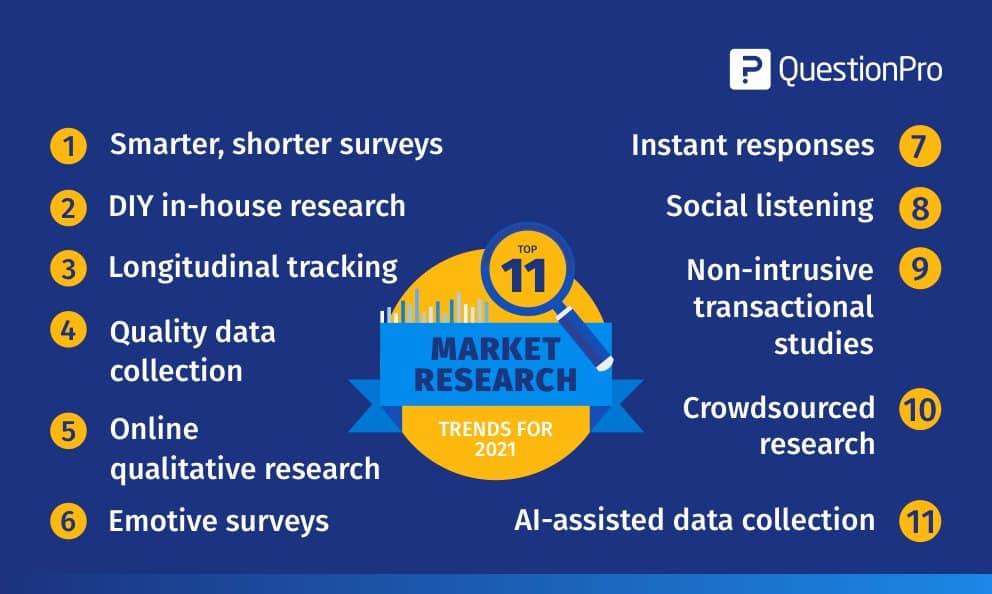
Smarter, shorter surveys
This trend gets talked about a lot, but the truth is that most researchers and research tools do not allow the ability to conduct smarter surveys. However, at the turn of 2020 and beyond, collecting the right data with good survey response rates and honest feedback is becoming increasingly important.
Capturing transactional data at the point of experience with a smart, short, and efficient survey helps with better data collection and consumer insights. Negating demographic data collection when that information is already available and using smarter research questions at the point of experience will help reduce survey fatigue and collect data that matters.
For example, to collect choice-based data that is a cornerstone of most research projects, adding an anchored MaxDiff question in your choice-based scaling will allow you to get deeper insights without having to conduct multiple follow-up studies.
Similarly, deploying omnichannel surveys at various touchpoints helps you collect the correct transactional data without compromising data quality.
DIY in-house research
For a long time, research has been considered a complex and labor-intensive process requiring extreme special qualifications to get right. In 2023, there will be a marked shift towards DIY in-house research with smarter research tools .
Simple to understand and deploy platforms without the need for complex scripting and powerful research questions is the way forward.
Conducting market research tools is the ability to collect quantitative and qualitative data with the bonus of having a good respondent base in one location. Gone are the days when each component required going to different platforms.
This will make the management of market research easier for all the stakeholders. DIY research and do-it-together (DIT) research, where the research tool provider chips with specialized research service
Longitudinal tracking
One of the biggest market research trends going into 2023 and beyond will be longitudinal studies and tracking. For far too long, research has relied on broken-down respondent sets that do not help gather a macro-level view of data and insights.
With the help of community management platforms , longitudinal research helps track behavior changes and derive market research industry trends in between external and internal factors on research and insights.
LEARN ABOUT: Market research industry
Not just that, longitudinal tracking also helps with quicker and faster turnaround research from members who matter the most to you and insights you can trust and co-create with. Having a ready set of opt-in research-ready respondents can help with ongoing monitoring studies and expedite your experience transformation initiatives.
Online qualitative research
One market research trend that has been a definite by-product impact of COVID-19 is online qualitative research. With limitations on in-person focus groups and other qualitative research methods, migrating this model online for continued tracking is the only option.
LEARN ABOUT: Qualitative Interview
But now that online focus groups are making an in-road in research models for research managers globally, there is a definite shift in understanding its value and importance. From using the right tool to manage data collection to gamification and digital rewards, moving your offline focus groups online has multiple benefits.
The ability to moderate video discussions while collecting data from a diverse target audience limited by geographical boundaries is a huge bonus.
Quality data collection
In a recent live video I did with the VP of Products at QuestionPro, Anup Surendran, we spoke about how hyper-personalization will help with better-quality data and insights. Going into 2023 and beyond, with the increase in the number of surveys a person is expected to respond to, standing out and collecting quality data will be challenging.
Personalizing data collection at the point of experience with intercept studies and smarter shorter surveys helps with data collection.
High-quality survey data reduces the time to market and aids insights management at costs that don’t cost an arm and a leg. Putting together studies that aid with high-frequency research and non-intrusive hyper-personalization will see higher levels of success going into 2023 and beyond.
Instant responses
Heading to a meeting and want some quick insights? Cannot choose between two names for a new product line and want quick responses?
Who wouldn’t like immediate insights from a group of respondents when you are stuck somewhere? In 2023, there will be a marked shift towards high-cadence, high-frequency studies with very high turnaround times.
Small surveys or polls that are set up and deployed within minutes and answers and analysis within minutes are the future of market research. Using a smart product that allows you to tap into a pre-defined and mobile-ready respondent population, the scope for quick turnaround studies is very high.
Using your existing technology stack and internal communication tools, and CRM, the use cases would be limitless if you could create and push out studies that offer you responses representing a larger population.
We at QuestionPro are building a mechanism that provides you with quick turnaround response times for short studies using our proprietary global panel of respondents to help you go from perceptions to decisions within minutes.
Non-intrusive transactional studies
The biggest pet peeve of people not wanting to participate in research studies and respond to surveys is the many pointless questions and many such surveys.
But what if you could gather customer delight with a customer experience platform that leverages non-intrusive transactional studies that are highly engaging, short, and compelling to respond to?
There will be a marked shift towards smarter customer engagement and monitoring studies that do not require respondents to fill in pointless surveys that include demographic data and repetitive information and can help manage customer satisfaction and legitimate NPS scores.
With the help of smart intercept studies, scores from across various touchpoints help draw a better understanding of customer delight and help show vectors and factors that could lead to customer churn.
Emotive surveys
One of the biggest trends in market research that I am most excited about is the added use of technology to capture respondent behavior and data with various factors like facial recognition and contactless surveys .
Surveys that help you capture customer insights where respondents do not have to interact with an external device and sentiments directly are captured just by facial and visual cues will be extremely important going into 2023 and beyond.
A simple question, for example, at a point of experience where facial recognition captures respondent sentiments will go a long way in offering mature insights for brands.
Crowdsourced research
Crowdsourcing in market research helps solve problems at scale with lower costs and makes it to our top 11 market research trends to keep an eye out for 2023. Since crowdsourcing uses the quali-quant method, the insights you can get from a diverse audience base are tremendous.
Not only can it help solve problems, but it also helps to get an idea of a more extensive and varied population. The only drawback of this method is that for a brand to effectively leverage this model, there has to be an advantage of scale, which increases crowdsourcing’s success and feasibility.
Social listening
Due to a large social media footprint, it is becoming increasingly important to listen to social media’s happening and derive sentiments from conversations. Since social media is highly emotive, there is a broader scope to get to the root of ideas, complaints, purchase behavior, macro, and micro trends, etc.
Using social listening, you can isolate the data you care about and look for short-term indicators around consumer research. This is the future of ethnographic research. While social listening doesn’t make sense for all market researchers and brands, if done well, it can help to identify actionable vectors at a very early stage.
AI-assisted data collection
Two common themes arose from market research in 2020 – personalization and convenience. Using AI-assisted data collection helps in advancing research for brands and researchers. The right data going to the right stakeholders in real time define the success metrics of market research.
By limiting human interactions but increasing milestones and points of experience-based smart research, there is greater success in collecting the right data. This helps focus on deriving insights from the data and not on the data collection itself.
For long-form data and open-ended data, AI-based research and sentiment analysis help derive insights from text-based data without intervening and manually interpreting it.
How QuestionPro helps in market research trends?
QuestionPro is a comprehensive online survey and market research platform that provides a variety of features and tools to help organizations remain ahead of market research trends. Here’s how QuestionPro can assist you:
Advanced survey creation
QuestionPro makes developing surveys with skip logic, several question kinds, and advanced customization easy. This flexibility lets researchers build surveys that follow market research trends and best practices.
Mobile-friendly surveys
QuestionPro lets researchers design mobile surveys. Given the rising trend of mobile survey participation, this assures a smooth and easy survey experience for respondents.
Automated survey distribution
QuestionPro distributes surveys via email, social media, and embedded surveys. These distribution choices help researchers to contact more respondents through digital media.
Advanced analytics and reporting
QuestionPro has comprehensive analytics and reporting tools that allow researchers to examine survey data and provide actionable insights. Researchers can use trend analysis, cross-tabulations, and statistical analysis tools to find patterns, trends, and correlations in data.
2023 will be a huge year for market research, and we are excited to play a pivotal role in making research easy and accessible to everyone. What market research trends are you looking forward to, and are you keeping an eye out for going into 2023 and beyond?
LEARN MORE FREE TRIAL
Frequently Asking Questions (FAQ)
By examining market trend data, investors can have a better understanding of how various assets have performed over time and make more informed decisions about where to put their money.
Artificial intelligence is the market research trend. It saves time and money and may increase data quality. In fact, 31% of researchers and brands believe an automated data quality solution can alleviate multiple business difficulties.
MORE LIKE THIS

Why You Should Attend XDAY 2024
Aug 30, 2024
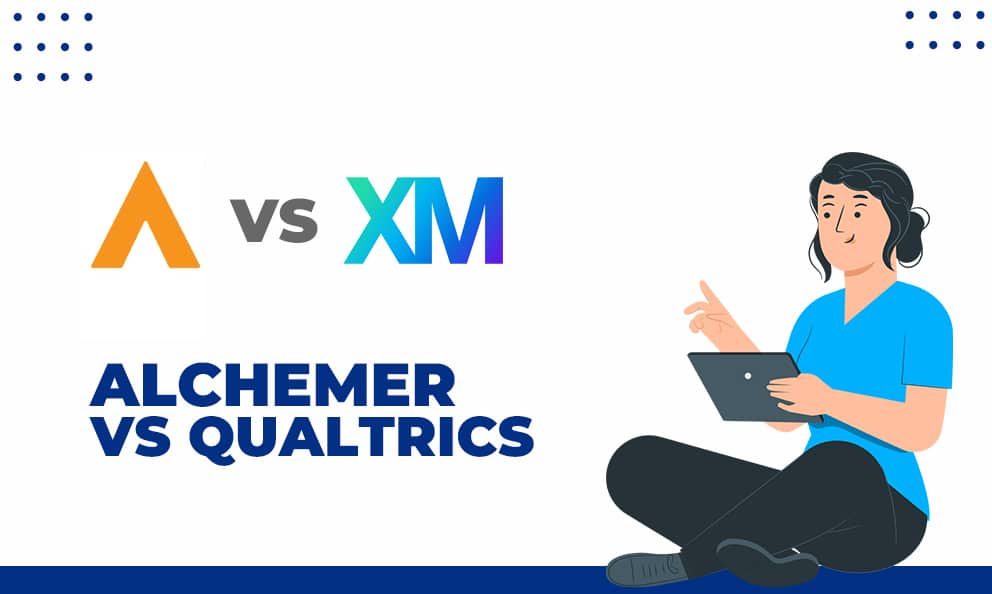
Alchemer vs Qualtrics: Find out which one you should choose

Target Population: What It Is + Strategies for Targeting
Aug 29, 2024

Microsoft Customer Voice vs QuestionPro: Choosing the Best
Other categories.
- Academic Research
- Artificial Intelligence
- Assessments
- Brand Awareness
- Case Studies
- Communities
- Consumer Insights
- Customer effort score
- Customer Engagement
- Customer Experience
- Customer Loyalty
- Customer Research
- Customer Satisfaction
- Employee Benefits
- Employee Engagement
- Employee Retention
- Friday Five
- General Data Protection Regulation
- Insights Hub
- Life@QuestionPro
- Market Research
- Mobile diaries
- Mobile Surveys
- New Features
- Online Communities
- Question Types
- Questionnaire
- QuestionPro Products
- Release Notes
- Research Tools and Apps
- Revenue at Risk
- Survey Templates
- Training Tips
- Tuesday CX Thoughts (TCXT)
- Uncategorized
- What’s Coming Up
- Workforce Intelligence
More From Forbes
Market research: an important investment for long-term viability.
- Share to Facebook
- Share to Twitter
- Share to Linkedin
Rick Kelly is the Chief Strategy Officer at Fuel Cycle . His passion is helping brands unlock the power of customer intelligence.
Businesses must future-proof themselves to endure an ever-changing economic landscape. Focusing on creating value both internally and externally through strategic planning is crucial for a brand's long-term success. Companies that prioritize market research as a fundamental function, rather than a mere expense, have a higher likelihood of thriving amid economic uncertainty.
Traditional market research, however, is often neither scalable nor fast and is often detached from decision-making processes. To stay competitive and gather relevant insights, organizations should consider embracing cutting-edge approaches and technological advancements in the market research sector.
The Future Of Market Research And The Role Of Data
Data has transformed the way companies approach future-proofing. Employing the right tools to collect valuable insights is crucial for businesses seeking long-term viability and brand success.
Market research enables businesses to:
1. Better comprehend their target audience's demographics and segment customers effectively.
2. Study competition and recognize market trends.
3. Guide product development and collect feedback from usability testing.
4. Assess the effectiveness of current marketing campaigns.
5. Develop powerful future marketing campaigns.
However, the life cycle of data's value has dramatically decreased. The driving force behind the speed of insights is the realization that if they take too long to generate, they may already be outdated upon arrival. It's essential for organizations to comprehend the context in which data exists, as context helps to inform the adjustments necessary for effective audience engagement.
Companies skimping on insight investment may suffer serious blows to brand perception. In fact, companies that embrace a customer-centric approach are 60% more profitable than companies that don't (pg. 5).
A lack of insights investment creates conflicts between consumer and brand alignment. Customer loyalty plummets— 80% of customers say they're more likely to switch brands after just one bad experience.
Market research leveraging real-time data creates an impact that teams can multiply exponentially through its potential to help organizations identify and address issues, pivot and even change business models.
Integrating Market Research Into Business Strategy
Gathering and utilizing market research data isn't as easy as it sounds. It can present several challenges and limitations that should be considered to maintain a balanced perspective and build trust with customers.
One challenge is the availability and accessibility of accurate data. Finding relevant and up-to-date information can be difficult depending on the industry or target market. Additionally, the quality and reliability of the data sources need to be carefully evaluated to ensure their credibility.
To start with market research, define your objectives and questions. This will guide your research efforts. Conduct an internal analysis of your business, including goals, target market and competition, to develop a research plan aligned with your strategy. Then, explore data collection methods.
Here are some key approaches.
1. Employing Online Communities: Online communities provide an invaluable source of ongoing insights from predetermined customer bases, allowing market researchers to gather the information that informs product development, gauges customer loyalty and drives innovation.
2. Focusing On Speed And Convenience In Online Community Tools: To deliver value for consumers in online communities, ensure that they are user-friendly and efficient, offering comprehensive data analytics tools, advanced qualitative research capabilities and customizable platforms.
3. Fostering Innovation: Market research should strive for continuous improvement by investing in UX research, DIY market research tools and refining AI technologies to enhance market research capabilities, improve customer experience and boost sales.
Embracing A New Mindset For Market Research
It is crucial to shift the perception of market research from an unnecessary expense to an indispensable function. Investments in research are integral to a company's operation, enabling them to identify growth opportunities and outperform competitors.
Traditional market research approaches often fall short in terms of scalability and speed while remaining too disconnected from decision-makers.
To thrive in a rapidly changing landscape, businesses must closely monitor customer sentiment by leveraging comprehensive data gathered from a centralized hub of market research tools, methodologies and intelligent processes that are designed to deliver actionable insights from a single source of truth.
Forbes Technology Council is an invitation-only community for world-class CIOs, CTOs and technology executives. Do I qualify?

- Editorial Standards
- Reprints & Permissions
- Recent Articles
The future of market research
From researcher to business partner: A new mindset for market researchers to elevate their value proposition

Life used to be so slow and easy.
When I was a marketing leader in the 1990s, everything was so easy…and much slower than today. The name of the game was to develop and produce the right piece of advertising. The ‘holy grail’ was to get a Well Above Normal score in copy testing. Then, the focus was to design the best media plan maximising the monthly GRP’s impact. In parallel, a couple of focus groups helped to unlock consumer insights to develop new innovative products. Quantitative research was instrumental in qualifying new concepts and estimating business potential. Add some PR and promotional budget…and we were building great brands! Engraved in stone, brand platforms were meant to last many years. Consumers were quite predictable. We could put them in a box for quite a long time. No digital transformation, no major concern about the future of our planet, no brand purpose. My internal consumer insights partners were leading the relationships with our contractors. We were buying well-rounded off the, shelf market research solutions. Yes, life was much slower and easier than today for brand builders, marketers, and innovators.
In the mid-2000s, when I started leading one of the largest global trend-forecasting consultancies, my insight-driven left brain was seriously challenged. Coming from a very analytical marketing culture, I suddenly realised that consumer insights were not the only source of innovation to imagine the future of a brand. Decrypting sociocultural, fashion, and design trends had become instrumental to understanding consumer emotions and to start building new kinds of experiences with brands and products. What was happening in the fashion arena had become a major source of inspiration for brands willing to go beyond functional benefits. Addressing needs was not enough to build brand preference. Brands really wanted to become Love Brands to create consumer desire. Suddenly, P&G created a global team of hundreds of 200 designers from scratch. Design, colours, materials, look & feel…were no longer semantics used by fashion stylists or electronic product designers. Marketers & innovators had to expand their market research toolbox to decipher not only unmet needs but also unarticulated desires. They had to start working with different talents: sociologists, semioticians, trend forecasters, “prospectivists”, designers, artists…But, even if a technology revolution was just about to change our lives, we were still able to picture what the next 3/5 years could look like.
Increasing complexity
Over the last ten years, the level of complexity has dramatically increased. After Millennials, GenZ has become a very complicated target to predict and decipher as they are showing many contradictory behaviours and attitudes, willing to save the planet daily (e.g. the second-hand fashion business is estimated to double at $250bn by 2026), but they keep on shopping at their favourite fast fashion retailers (Schein, Primark…). They are moving targets, and so are many other age groups that are now being defined by their lifestyle, their values…and no longer by where they are living, their yearly wage or their level of education.
In parallel, the digital and technological revolution has made social networks a very complex and fast-changing space to analyse. Forums, Google queries, photos, videos, user-generated content, and influencers’ posts have created a brand-new world. Newcomers like Tik Tok have completely disrupted the market in less than two years, seriously challenging Meta (ex FB). New AI / tech-driven solutions have been developed to cope with this huge volume of information (“infobesity”). Looking forward, even if Metaverse triggers many contradictory hopes, it will most likely be the next (r)evolution that will require new skills & new techniques to navigate it.
Brand Leaders, marketers, innovators, product developers, and market researchers have also had to deal with an increase in the pace of business, i.e. a fast-changing environment that requires much more responsive solutions and an agile mindset which can immediately sense new market dynamics and adjust brand building & marketing strategies. If it was still credible to claim that some forward-looking market research could help to set a 5-year vision ten years ago, unexpected events like COVID-19, inflation, and an energy crisis… have completely changed the way we are now dealing with our near future. “Winter is coming” is no longer a scary punch line from a TV series but a true fear in a world with less gas and where health concerns have dramatically become a central preoccupation alongside sustainable development. We are now hitting the wall, and the clock is ticking.
Changes and the market research industry
These dramatic and radical changes have had an impact on the market research industry and on researchers who look to help their clients to navigate the complexity of all new research techniques to understand their… complex consumers. Answers to these changes are no longer to sell one service but a comprehensive portfolio of solutions, to deliver less “key learnings slides” but more actionable guidelines to accelerate the decision-making process, to move from a solution provider to a true consultant stand with strong point of views, intuition and imagination.
Market researchers should, therefore, not be on-demand experts anymore. They must be real marketers and innovators’ partners working closely together every day to decrypt embryonic emerging signs before they become trends, to spot “anomalies” on social networks that could be evidence of major consumer shifts, to track brand equity strategic items to enable swift adjustment decisions, to fast-track innovation by informing the process with forward-looking insights & foresight, to have a deep understanding of a given product category at a time when a small invisible start-up can disrupt a business…All this takes a daily and ongoing effort - a true partnership.
Eric Duchamp
Global business & team leader with cutting-edge insights into future market trends and the ways brands can leverage disruptive business, brand, marketing & innovation strategies to effectively compete. Expertise in leading fast-track strategic innovation initiatives in multiple industries: fashion, beauty, luxury brands,, consumer brands, retail and more. Proven success in achieving breakthrough growth, global expansion, new organizational capabilities design, and profitable turnarounds. Clients have included L’Oréal, Estée Lauder, Coty, Unilever, Henkel, Chanel, YSL, Lacoste, Nike, H&M, VF Corp, Lululemon, Stitch Fix, Auchan, Carrefour, Galeries Lafayette, Manor, Nordstrom, Walmart, Target, Orange, Huawei, Samsung, and other well-known Chinese branded retailers

Hot, hot, hot! Too hot? Can the investment boom last?

Innovation in inflationary times Part 1

Discussing the dimensions of enterprises vs agencies
In addition to using essential cookies that are necessary to provide you with a smooth navigation experience on the website, we use other cookies to improve your user experience. To respect your privacy, you can adjust the selected cookies. However, this might affect your interaction with our website. Learn more about the cookies we use.

An official website of the United States government
Here’s how you know
Official websites use .gov A .gov website belongs to an official government organization in the United States.
Secure .gov websites use HTTPS A lock ( ) or https:// means you’ve safely connected to the .gov website. Share sensitive information only on official, secure websites.

- Explore sell to government
- Ways you can sell to government
- How to access contract opportunities
- Conduct market research
- Register your business
- Certify as a small business
- Become a schedule holder
- Market your business
- Research active solicitations
- Respond to a solicitation
- What to expect during the award process
- Comply with contractual requirements
- Handle contract modifications
- Monitor past performance evaluations
- Explore real estate
- 3D-4D building information modeling
- Art in architecture | Fine arts
- Computer-aided design standards
- Commissioning
- Design excellence
- Engineering
- Project management information system
- Spatial data management
- Facilities operations
- Smart buildings
- Tenant services
- Utility services
- Water quality management
- Explore historic buildings
- Heritage tourism
- Historic preservation policy, tools and resources
- Historic building stewardship
- Videos, pictures, posters and more
- NEPA implementation
- Courthouse program
- Land ports of entry
- Prospectus library
- Regional buildings
- Renting property
- Visiting public buildings
- Real property disposal
- Reimbursable services (RWA)
- Rental policy and procedures
- Site selection and relocation
- For businesses seeking opportunities
- For federal customers
- For workers in federal buildings
- Explore policy and regulations
- Acquisition management policy
- Aviation management policy
- Information technology policy
- Real property management policy
- Relocation management policy
- Travel management policy
- Vehicle management policy
- Federal acquisition regulations
- Federal management regulations
- Federal travel regulations
- GSA acquisition manual
- Managing the federal rulemaking process
- Explore small business
- Explore business models
- Research the federal market
- Forecast of contracting opportunities
- Events and contacts
- Explore travel
- Per diem rates
- Transportation (airfare rates, POV rates, etc.)
- State tax exemption
- Travel charge card
- Conferences and meetings
- E-gov travel service (ETS)
- Travel category schedule
- Federal travel regulation
- Travel policy
- Explore technology
- Cloud computing services
- Cybersecurity products and services
- Data center services
- Hardware products and services
- Professional IT services
- Software products and services
- Telecommunications and network services
- Work with small businesses
- Governmentwide acquisition contracts
- MAS information technology
- Software purchase agreements
- Cybersecurity
- Digital strategy
- Emerging citizen technology
- Federal identity, credentials, and access management
- Mobile government
- Technology modernization fund
- Explore about us
- Annual reports
- Mission and strategic goals
- Role in presidential transitions
- Get an internship
- Launch your career
- Elevate your professional career
- Discover special hiring paths
- Climate Action
- Events and training
- Agency blog
- Congressional testimony
- GSA does that podcast
- News releases
- Leadership directory
- Staff directory
- Office of the Administrator
- Federal Acquisition Service
- Public Buildings Service
- Staff offices
- Board of Contract Appeals
- Office of Inspector General
- Region 1 | New England
- Region 2 | Northeast and Caribbean
- Region 3 | Mid-Atlantic
- Region 4 | Southeast Sunbelt
- Region 5 | Great Lakes
- Region 6 | Heartland
- Region 7 | Greater Southwest
- Region 8 | Rocky Mountain
- Region 9 | Pacific Rim
- Region 10 | Northwest/Arctic
- Region 11 | National Capital Region
- Per Diem Lookup
Making Market Research Easy - Enhancing Industry Partnerships
Join the GSA Office of Small and Disadvantaged Business Utilization and the GSA Federal Acquisition Service Office of Customer & Stakeholder Engagement (CASE) as they team to provide innovative insights on how to respond to GSA’s RFIs. Learn experts’ tips and tricks on how to fill out these important surveys. By participating in this session, you will better understand why GSA collects industry responses and how the data gathered shapes future purchasing decisions. Take advantage of this opportunity to learn and improve your business practices!
Learning objectives include:
- Why market research is conducted
- Overview of the Market Research as a Service (MRAS) Program
- Effectively completing MRAS RFI Surveys
- Ensuring customers get accurate information about your capabilities
- What GSA does with the results
This webinar is free and open to all of industry.
Presenter: Kerry Durkan, Marketing Research Analyst, GSA FAS CASE
PER DIEM LOOK-UP
1 choose a location.
Error, The Per Diem API is not responding. Please try again later.
No results could be found for the location you've entered.
Rates for Alaska, Hawaii, U.S. Territories and Possessions are set by the Department of Defense .
Rates for foreign countries are set by the State Department .
2 Choose a date
Rates are available between 10/1/2022 and 09/30/2025.
The End Date of your trip can not occur before the Start Date.
Traveler reimbursement is based on the location of the work activities and not the accommodations, unless lodging is not available at the work activity, then the agency may authorize the rate where lodging is obtained.
Unless otherwise specified, the per diem locality is defined as "all locations within, or entirely surrounded by, the corporate limits of the key city, including independent entities located within those boundaries."
Per diem localities with county definitions shall include "all locations within, or entirely surrounded by, the corporate limits of the key city as well as the boundaries of the listed counties, including independent entities located within the boundaries of the key city and the listed counties (unless otherwise listed separately)."
When a military installation or Government - related facility(whether or not specifically named) is located partially within more than one city or county boundary, the applicable per diem rate for the entire installation or facility is the higher of the rates which apply to the cities and / or counties, even though part(s) of such activities may be located outside the defined per diem locality.
- Our Latest Research
- 2024 Research Agenda
- Competitive Intelligence Reports
- Horizons and Top 10 Reports
- Hot Tech Reports
- Market Challenger Reports
- Market Impact Reports
- Pulse Dashboard
- Generative Enterprise
- OneOffice Mindset & Horizon 3 Innovation
- People and Process Change
- Artificial Intelligence
- Automation & Process Intelligence
- Data and Decisions
- Low-code No-code GenerativeAI Code
- Customer and Employee Experience
- Finance & Accounting
- Sourcing & Procurement
- Supply Chain
- Sustainability and ESG
- Cloud Native Transformation
- Digital Trust and Cybersecurity
- Digital Engineering Services
- Enterprise Platforms
- Banking and Financial Services
- Energy and Utilities
- Industrial Manufacturing
- Life Sciences
- Retail and Consumer Packaged Goods
- Technology, Media, and Communications
- Travel, Hospitality, and Logistics
- Enterprise Advisory Services
- HFS Engagement Programs
- HFS Summits
- HFS Roundtables
- All Videocasts
- Unfiltered Stories
- Our Leadership Team
- The HFS OneCouncil
- Strategic Alliances
- In the News
- Become a client
- General Inquiry
- Analyst Inquiry
| If you don't have an account, |
| | |
Point of View
Retail’s make-or-break moment: Embark on the HFS ‘Future of Retail’ framework now
The retail industry stands at a critical inflection point. The convergence of evolving consumer expectations, relentless technological disruption, and the inexorable demand for sustainability has rendered antiquated retail models obsolete. Retailers with a rudimentary transaction-based approach will likely lose 30-50% of their current revenue base in the next five years. To secure continued relevance and competitive viability, retailers must unreservedly embrace the HFS ‘Future of Retail’ framework. Rooted in real-world developments, the framework delineates a structured approach to navigating the complexities and capitalizing on the opportunities of this new technology-led era.
The current retail paradigm is generic, cumbersome, and disintegrated
As Exhibit 1 illustrates, the current retail ‘modus operandi’ presents several challenges for consumers as it is limited by design.
Exhibit 1: The retail customer is frustrated by the non-intuitive and transactional nature of retail experiences

Source: HFS Research, 2024
Retailers with this rudimentary mindset have been experiencing significant customer churn (up to 30%), a continuous dip in market share (3-5% per year), and cost overruns of more than 20% because of operational inefficiency. Therefore, it’s imperative to reimagine your operations with a structured transformation approach.
Retail’s existential crossroad—embark on the ‘Future of Retail’ framework
The HFS ‘Future of Retail’ framework (see Exhibit 2) has two intertwined layers. The inner layer focuses on the operational and technological components, and the outer layer focuses on stakeholder experience and sustainability.
Exhibit 2: The ‘Future of Retail’ framework professes a customer-oriented paradigm enabled by tech

Decoding the inner layer—operational and technological components
- Anticipatory digital: The transition from transactional interactions to personalized, experience-driven relationships is non-negotiable. Retailers must harness data and AI to deliver experiences that are not only personalized but anticipatory. For example, they can leverage machine learning to offer tailored suggestions based on individual customer behavior, preferences, and past interactions. They can also utilize AI to predict and respond to customer intent even before they explicitly search for a product or service. For instance, after selling a printer, given the ink cartridge’s average consumption time, send effective and personalized follow-up emails about availability, pricing, and possible promotions for that model’s specific brand of ink cartridges. Use marketing automation tools in combination with real-time triggers and AI-driven algorithms to achieve this.
- Experiential (physical) store: The role of the physical store must undergo a complexion and functional change. It can no longer be merely a point of sale. It must serve as an experiential hub and a micro-fulfillment center. On the one hand, the store must deliver a digital-like experience by leveraging technologies such as virtual shelves, endless aisles, AI-assisted product selection, digital pricing tags, and automated checkouts. On the other hand, a part of the store must be utilized as a micro-fulfillment center. This can significantly address the last-mile fulfillment and reverse logistics challenges. Walmart’s integration of stores as fulfillment centers has led to a 30% reduction in last-mile delivery costs.
- Autonomous supply chain: Leverage AI, automation, and IoT technologies to construct more resilient and agile supply chains. Utilize AI-driven forecasting for demand planning, inventory management, and replenishment. Implement robotics and automated systems in warehousing, packaging, and distribution. Leverage IoT for real-time tracking of goods, improving visibility, and reducing inefficiencies. Zara’s agile supply chain model has enabled the brand to slash lead times by 50% and swiftly respond to constantly shifting consumer demands.
- Unified commerce: Ensure a seamless shopping experience across online and offline channels with consistent branding, pricing, and customer service. By integrating online and offline channels through cloud and other relevant omni-channel retail solutions, retailers can capture a broader customer base and drive incremental sales, potentially boosting total revenue by 5-10%. This is also a great way of futureproofing your business against black swan events such as the COVID-19 pandemic. Best Buy is a great example of a retailer that experienced relatively less disruption during the 2020-21 mayhem owing to tight integration among its various customer touchpoints.
The outer layer advocates focusing on stakeholder experience and sustainability
- Customer experience: Retailers must create touchpoints that foster engagement throughout the customer journey—from discovery to post-purchase support. These touchpoints include targeted marketing campaigns, personalized recommendations, consistent purchase experience, loyalty program enrollment, quick customer support, follow-up communications, feedback loops, referral bonuses, social media engagement, and exclusive offers. Moreover, develop a mechanism for monitoring and optimizing employee performance across various channels (physical stores, online, call centers) to ensure a consistent and high-quality customer experience.
- Employee experience: Employee experience must be handled based on the nature of work, which differs for a store associate vs. a contact center agent. For instance, store associates should be empowered through wearables or mobile apps for associate-to-associate and associate-to-store communication to combat out-of-stock situations and resolve customer and operational issues in real time. This also will ensure they are not physically tired due to unnecessary movement across the shop floor.
- Partner experience: Facilitate the integration of supplier and retailer systems for better coordination and efficiency. For instance, Walmart’s vendor-managed inventory (VMI) system enables suppliers to manage their products in Walmart’s warehouses. Suppliers monitor inventory levels and ensure their products are replenished as needed.
- Transparency and information disclosure: Providing customers and stakeholders with clear and accessible information about product sourcing, production processes, and environmental impact.
- Reusability and recycling: Implementing practices that promote the reuse of materials and the recycling of products to minimize waste.
- Green practices: Adopting and promoting sustainable business practices, such as reducing carbon footprints, using renewable energy, and supporting environmentally friendly initiatives.
The Bottom Line: Forward-looking retailers must simultaneously progress on the various dimensions of the HFS ‘Future of Retail’ framework to meet the heightened expectations of the new-age consumer.
As retail is a low-margin business and infrastructure investments tend to scale linearly, all the technological, operational, and business initiatives must be measured against improvement in financial performance, brand perception, operational efficiency, and customer satisfaction.
Sign in to view or download this research.
Email address *
Password *
Remember me
Lost your password?
Insight. Inspiration. Impact.
Register now for immediate access of HFS' research, data and forward looking trends.

Ashish Chaturvedi Practice Leader
- Accenture’s ANSR acquisition to reshape enterprise innovation and business strategy
- Celonis’ Process Intelligence Graph strives to drive OneOffice from thought to reality
- Use our framework to win as a Generative Enterprise™
- American Growth Project
- Kenan Insights
- Attend Event
- Affiliated Centers
Shaping North Carolina’s Future with Jim Johnson
- &title=Shaping North Carolina’s Future with Jim Johnson&source=https%3A%2F%2Fkenaninstitute.unc.edu%2Fcommentary%2Fshaping-north-carolinas-future-with-jim-johnson%2F">
North Carolina is one of the fastest-growing states in the country, experiencing robust economic growth through both an increasing population and the attraction of new businesses. Between 2020 and 2023 alone, the state’s population grew by 3.8%, outpacing both the national (1.0%) and the South’s (3.1%) rates of population growth (see Figure 1). 1 As the state evolves politically and demographically, the November election will address several critical issues that will shape its future. Jim Johnson, director of the Urban Investment Strategies Center and William R. Kenan Jr. Distinguished Professor of Strategy and Entrepreneurship at UNC Kenan-Flagler Business School, discusses in this interview how his research sheds light on these key issues and offers insights into the challenges and opportunities facing North Carolina.
Your research spans a variety of topics, from demographic shifts to economic development. What overarching patterns or themes have emerged, and why are they critically important in North Carolina today?

Jim Johnson: Over the past three decades, North Carolina has been one of the nation’s major migration destinations. People moving from other states and abroad were responsible for 95% of North Carolina’s growth (396,022) between 2020 and 2023 (see Figure 2). And migration has accounted for nearly all of North Carolina’s population growth of over 4 million people since 1990. 2
For two consecutive years, North Carolina ranked as America’s top state for business. However, we recently dropped to No. 2 in CNBC’s rankings, and there has been a notable slowdown in the rate of in-migration alongside an increase in out-migration. Between 2022 and 2023, the state's net migration rate dropped from 317 newcomers daily to 220, signaling that some key factors – like affordability, infrastructure and inclusiveness – might be slipping. 3
While North Carolina remains attractive as a place to live and do business, the state may be losing some of its shine because of changes in quality of life metrics, including crime, childcare, healthcare, environmental quality and inclusiveness. For instance, childcare shortages have led to increased costs, with the average cost of infant care now exceeding $9,100 annually in the state. 4 This strains working families and poses challenges for retaining talent.
Moreover, recent migration-induced growth has masked profound changes in the state's population composition, affecting our ability to produce the workforce required for economic development. Our growth is largely driven by people of color, who contributed to 69% of the state’s net population increase between 2020 and 2023 (see Figure 3). 5 Yet, we are pushing back on diversity, equity and inclusion precisely when we need all hands on deck to remain innovative and competitive.
North Carolina’s population is also aging. Between 2020 and 2023, the state's senior population grew by 11.2%, outpacing the total (3.8%), preschool age (1.1%), school age (0.5%) and working-age (2.9%) population growth rates (see Figure 4). 6 This demographic shift, coupled with normal age-related mortality, deaths of despair among prime working-age males, and declining male college enrollment, is creating a demographic depression in our labor market. For example, the state has seen a 20% increase in deaths of despair – particularly opioid overdoses – since 2018, which has disproportionately affected men ages 25-44. 7 These deaths represent a long-term economic loss, as each of these individuals could have contributed decades of productivity to the state’s economy.
The collective impact of these disruptive demographic trends have far-ranging and geographically expansive implications for the state’s ability to create and maintain a competitive workforce, especially when viewed in conjunction with below-replacement-level fertility – another long-standing trend affecting the size and composition of the population of our nation and the state. Emblematic of both the scope and magnitude of the impact of these combined forces, deaths exceeded births in 80 of North Carolina’s 100 counties between 2020 and 2023 (see Figure 5).
Your work on the nursing profession emphasizes the importance of understanding "iceberg demographics." Can you discuss how these hidden demographic trends also influence North Carolina’s attractiveness as a migration destination?
Jim Johnson: The concept of " iceberg demographics " arises from the pushback on race and gender equality, coupled with growing labor activism. Post-COVID, we’ve witnessed increased labor activism, including walkouts, strikes, resignations and pushback on mandatory return-to-office mandates. During the pandemic, people reflected on their lives, and many challenges workers face today are not visible to the naked eye, much like an iceberg.
Iceberg Demographic Schema
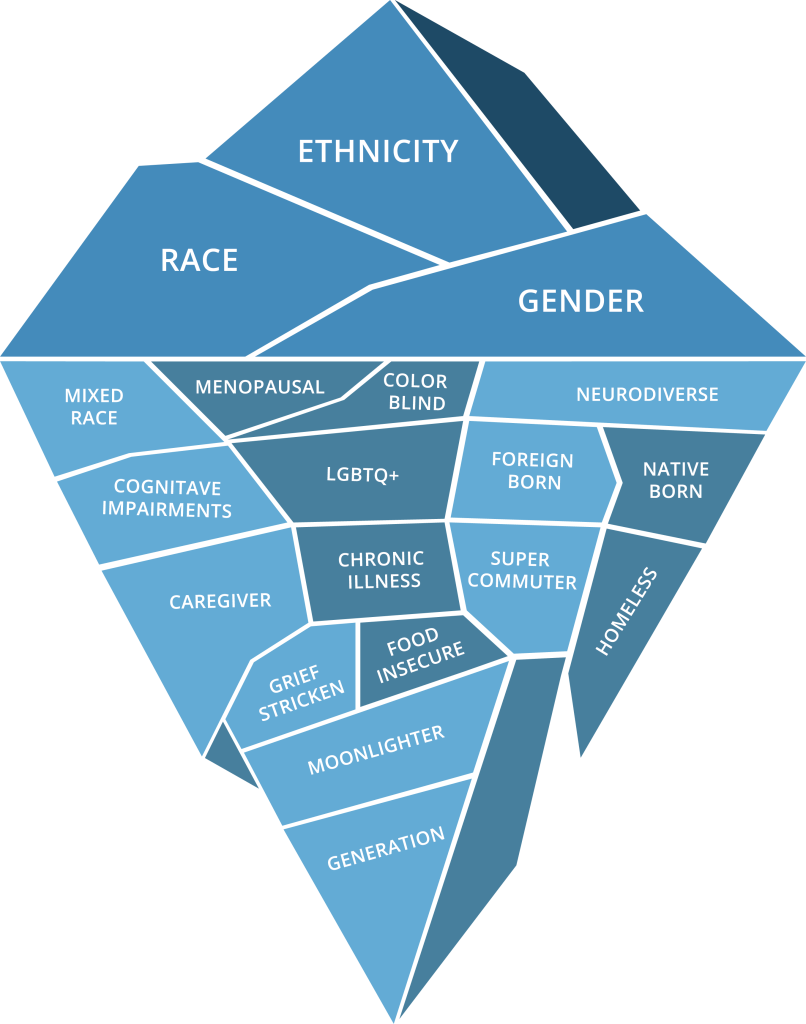
These "iceberg demographics" are the invisible attributes that shape individuals' lives but are not readily apparent. For example, over 60% of women ages 45-54 in the workforce are managing menopausal symptoms, but very few companies have policies or resources in place to accommodate them. 8 Understanding these hidden factors is crucial for successfully recruiting and retaining workers today. People analytics will become the norm, as companies will need to modify workplace policies, practices and procedures to accommodate the diverse needs of their employees. In a state like North Carolina, where net migration has been a significant driver of growth, these invisible demographics could greatly influence whether people choose to move here or take their talent elsewhere.
Given demographic headwinds such as an aging population and below-replacement-level fertility, what strategies should North Carolina adopt to maintain its economic vitality?
Jim Johnson: First and foremost, we need to push for comprehensive immigration reform at the national level. As an aging state with declining fertility, we need labor, and if we can’t reproduce it, we must import it. Immigration is an age-selective process, and young immigrants are crucial for our labor force. Currently, immigrants account for roughly 12% of North Carolina’s workforce. 9 Without them, sectors like construction, healthcare and agriculture would face critical labor shortages.
Additionally, we should invest in age-friendly infrastructure and the longevity economy. North Carolina’s senior population will exceed 2.8 million by 2035, presenting enormous business and job opportunities in fields like healthcare, housing and elder care services. 10 Age-friendly cities are also key for retaining older residents, ensuring they remain active participants in the economy.
Embracing a "bring back our own population" strategy can help rebuild dying counties and those experiencing biological decline. Currently, 80 counties in North Carolina have more deaths than births. 11 By incentivizing young and middle-aged talent – particularly those with remote work opportunities – to return to their hometowns where they have location-specific capital in the form of aging parents, grandparents and other relatives, we can begin reversing these trends.
How do you see the future of North Carolina’s demographic trends affecting the state’s education system and workforce readiness ?
Jim Johnson: We are facing significant challenges due to deaths of despair, declining fertility and the sex ratio imbalance in higher education. The sex ratio in higher education has been 60% female and 40% male for four decades, creating a shortage of marriageable males and affecting family structure and child-rearing. 12 As a result, the number of births in the state has declined sharply. In 2022, North Carolina recorded just over 118,000 births, compared with over 132,000 in 2008. 13 This declining fertility rate is leading to a potential enrollment cliff in both K-12 and higher education.
Additionally, deaths of despair are concentrated among prime working-age males, ages 25-44, whose premature deaths rob the state of critical labor force contributions. 14 For example, opioid-related deaths have increased by 35% since the pandemic began, contributing to the loss of nearly 14,000 potential workers over the past decade. 15 These trends will affect our ability to cultivate a workforce that is competitive on a national and global scale.
Your coming research suggests that anti-DEI policies could hinder North Carolina's growth. Can you explain how these policies might affect the state's ability to attract and/or retain a diverse talent pool?
Jim Johnson: Anti-DEI policies could lead to a decline in North Carolina's attractiveness as a destination, as people increasingly vote with their feet and choose more inclusive environments. We know from a recent survey that 88% of young professionals under 35 would consider not taking a job or moving to a state that did not support reproductive rights or DEI initiatives. 16 With 80 counties where deaths exceed births, we cannot afford to lose anyone. 17
Pushing an anti-DEI agenda hampers our ability to develop and retain the talent needed to move our state forward. It’s not just a moral issue – it’s an economic imperative.
Based on your findings, what are the most critical actions that North Carolina must take to ensure it remains a top destination for business, innovation and quality of life?
Jim Johnson: Embracing diversity as a form of enlightened self-interest is essential given the disruptive demographic trends we are experiencing. We must address deaths of despair and the loss of young, working-age individuals to premature disabilities and deaths. Currently, North Carolina has one of the highest rates of opioid-related deaths in the Southeast, with over 3,000 deaths annually. 18 Tackling this issue head-on is vital for the health of our workforce.
Developing an affordable workforce housing strategy for public school teachers and civil servants is crucial. Right now, over 50% of North Carolina’s teachers report struggling to find affordable housing near their schools. 19 Demonstrating a commitment to climate and environmental justice will also enhance our state’s appeal, as extreme weather events and environmental degradation increasingly affect where people choose to live and work.
Investing in R&D in the business of aging and creating age-friendly infrastructure will capitalize on opportunities presented by an aging population. Finally, rebranding North Carolina as a place where empathy and compassion are core operating principles will help attract and retain talent. Prioritizing these actions will ensure that North Carolina remains a top destination for business, innovation and quality of life.
1 Annual and Cumulative Estimates of the Components of Resident Population Change for the United States, Regions, States, District of Columbia, and Puerto Rico: April 1, 2020 to July 1, 2023 (NST-EST2023-COMP) Source: U.S. Census Bureau, Population Division Release Date: December 2023
2 Annual and Cumulative Estimates of the Components of Resident Population Change for the United States, Regions, States, District of Columbia, and Puerto Rico: April 1, 2020 to July 1, 2023 (NST-EST2023-COMP). U.S. Census Bureau, Population Division Release Date: December 2023.
3 North Carolina Office of State Budget and Management. (2023). State migration trends and estimates: 2022-2023. Retrieved from https://www.osbm.nc.gov/data
4 Child Care Aware of America. (2023). The U.S. and the high price of child care: An examination of a broken system. Retrieved from https://www.childcareaware.org
5 Annual Estimates of the Resident Population by Sex, Race, and Hispanic Origin for North Carolina: April 1, 2020 to July 1, 2023 (SC-EST2023-SR11H-37). U.S. Census Bureau, Population Division Release Date: June 2024
6 Annual Estimates of the Resident Population for Selected Age Groups by Sex for North Carolina: April 1, 2020 to July 1, 2023 (SC-EST2023-AGESEX-37). U.S. Census Bureau, Population Division Release Date: June 2024
7 North Carolina Department of Health and Human Services. (2023). Deaths of despair report: Opioid overdose trends in North Carolina, 2018-2023. Retrieved from https://www.ncdhhs.gov
8 North American Menopause Society. (2023). Menopause in the workplace: Impacts and statistics. Retrieved from https://www.menopause.org
9 Migration Policy Institute. (2023). Immigrants in the U.S. states: Workforce data for North Carolina. Retrieved from https://www.migrationpolicy.org
10 North Carolina Office of State Budget and Management. (2023). North Carolina population projections: 2020-2035. Retrieved from https://www.osbm.nc.gov/data
11 North Carolina Department of Health and Human Services. (2023). Vital statistics report: Births and deaths by county, 2023. Retrieved from https://www.ncdhhs.gov
12 National Center for Education Statistics. (2023). Enrollment and graduation rates by gender in higher education: A 40-year analysis. Retrieved from https://nces.ed.gov
13 North Carolina Department of Health and Human Services. (2023). Birth statistics report: 2008-2022. Retrieved from https://www.ncdhhs.gov
14 North Carolina Department of Health and Human Services. (2023). Deaths of despair: Impact on the labor force in North Carolina. Retrieved from https://www.ncdhhs.gov
15 North Carolina Department of Health and Human Services. (2023). Opioid overdose trends and workforce impact: 2013-2023. Retrieved from https://www.ncdhhs.gov
16 Pew Research Center. (2023). Young professionals' attitudes towards reproductive rights and DEI initiatives in the workplace. Retrieved from https://www.pewresearch.org
17 North Carolina Department of Health and Human Services. (2023). Vital statistics report: Births and deaths by county, 2023. Retrieved from https://www.ncdhhs.gov
18 North Carolina Department of Health and Human Services. (2023). Annual opioid overdose death report. Retrieved from https://www.ncdhhs.gov
19 North Carolina Association of Educators. (2023). Teacher housing affordability survey: 2023 report. Retrieved from https://www.ncae.org
- Keyword(s):
- demographics 10
- economic development 40
- north carolina 60
- workforce development 65

Urban Investment Strategies Center

Jim Johnson
William R. Kenan Jr. Distinguished Professor of Strategy and Entrepreneurship, Director of the Urban Investment Strategies Center
You may also be interested in:
- Kenan Institute of Private Enterprise
- Kenan Institute
- Kenan Scholars
- Find an Expert
- Sign up to receive communications from the Kenan Institute of Private Enterprise
- Manage Subscriptions
Home • Water Industry Insights • U.S. & Canada Digital Water Market Outlook: Key Drivers, Competitive Shifts, and Forecasts, 2024–2033
U.S. & Canada Digital Water Market Outlook: Key Drivers, Competitive Shifts, and Forecasts, 2024–2033
The U.S. and Canada have long been at the forefront of digital water adoption, shaped by a diverse network of assets, an expansive roster of technology vendors, and relative access to capital. As such. Bluefield Research anticipates strong demand for digital water solutions in North America, underpinning a cumulative US$169.5 billion in spending from 2024 to 2033.
This growth is fueled by several key factors: the need for increased efficiencies in asset and operations management, which is becoming ever more critical due to a growing workforce gap; shifts in policy and government funding that are incentivizing digital technology adoption; and the increasingly ubiquitous deployment of technology across all aspects of critical infrastructure. These drivers also usher in the increasingly complex challenges associated with cybersecurity.
As utility demand intensifies, from very large to very small utilities, the vendor landscape is becoming more competitive. The market is currently dominated by established water technology players, many of which are based in the U.S. and Canada. However, new market entrants are making inroads through strategic acquisitions and partnerships, while emerging startups are challenging the status quo, especially with software-based solutions.
This Insight Report ( and related data dashboard) offers a comprehensive analysis of the U.S. & Canada digital water market, including hardware, software, services, and connectivity. Bluefield’s bottom-up approach provides a detailed view of the current landscape and future growth, along with insights into major drivers and trends, the competitive environment, and detailed company profiles of 15 major digital water incumbents.
Table of Contents
Section 1: U.S. & Canada Digital Water Market Drivers & Trends
- Drivers and Inhibitors Impacting the Digital Water Market
- Challenges and Solutions – Digital Water Addresses Industry Pain Points
- Digital Maturity – Differing Needs and Experiences
- Landscape Fragmentation – Diverging Digital Water Priorities
- Driving Change – Policies and Government Funding Influence Investments
- Slow and Steady – IIJA Funding Presents Opportunities for Digital Water
- Silver Tsunami – Utility Workforce Trends
- Cybersecurity – Rising Concern, Limited Capacity
- Internal Challenges – Barriers to Digital Water Adoption
Section 2: U.S. & Canada Digital Water Market Forecasts
- Bluefield Digital Water Market Model Overview
- Asset Base – U.S. Utility Landscape
- Asset Base – Canada Utility Landscape
- Quantifying Spend – Digital Water Pricing by Utility Size
- The Big Picture – U.S. & Canada Digital Water Market Opportunity
- 10-Year Spend – Legacy Solutions Account for Lion’s Share
- Digital Water Hot Spots – Market Size by U.S. State
- Digital Water Hot Spots – Market Size by Canadian Province
- Digital Water Solutions Come Online – Market Outlook by Product Type
- Water Utilities Spearhead Investments – Market Outlook by Water Type
- OPEX Outpaces CAPEX – Market Outlook by Spend Type
- Growth Opportunities Across the Board – Market Outlook by Utility Size
- Digital Drives Optimization – Network & Plant Mgmt. Market Outlook
- Beyond Meter to Cash – Metering & Customer Mgmt. Market Outlook
- Reactive to Proactive – Work & Asset Mgmt. Market Outlook
- Next Steps in Digital Transformation – Information Mgmt. Market Outlook
- Securing IT and OT – Cybersecurity Market Outlook
- Leveraging Data – AI/ML Enhances Digital Water Solutions
- Push to the Cloud – Digital Water Software Adoption Trends
Section 3: Competitive Landscape
- Key Competitive Trends Emerging Across Digital Water Landscape
- Vendor Growth – Riding the Technology Wave
- Portfolio Expansion – Organic and Inorganic Growth Strategies
- Acquisition Hot Spots – Digital Water M&A Trends in the U.S. & Canada
- Market Consolidation – Strategic Growth via M&A
- Capital Flows – Investments Support Early-Stage Growth
- Notable M&A and VC Investment Deals
- Vendor Landscape – Hardware and Software Companies
- Beyond Technology – The Role of Service Providers
Section 4: Key Company Profiles
- Badger Meter
- Bentley Systems
- IDEX Corporation
- Mueller Water Products
- Neptune Technology Group
- Rockwell Automation
Companies Profiled
Companies mentioned.
- U.S. Digital Water Forecasts, 2024–2033
- Canada Digital Water Forecasts, 2024–2033
Related Water Industry Insights
Global digital water incumbents: top company strategies and rankings, 2024 u.s. elections: implications for the water industry, digital twins in water: market overview, competitive trends, and key profiles, related podcast, from milestones to predictions: what’s next for the future of water , have ongoing analysis needs.
Our subscription services provide you with monthly, up to date data on the topics.
Subscribe to our Waterline newsletter

Research conducted for investments in sustainable finance suggests that sustainable finance in London provides numerous products and services for the clean energy transition . These services would support the green energy transition to achieve net zero emissions by the end of 2050. Clean energy transition requires development in the energy market, promoting the shift towards…
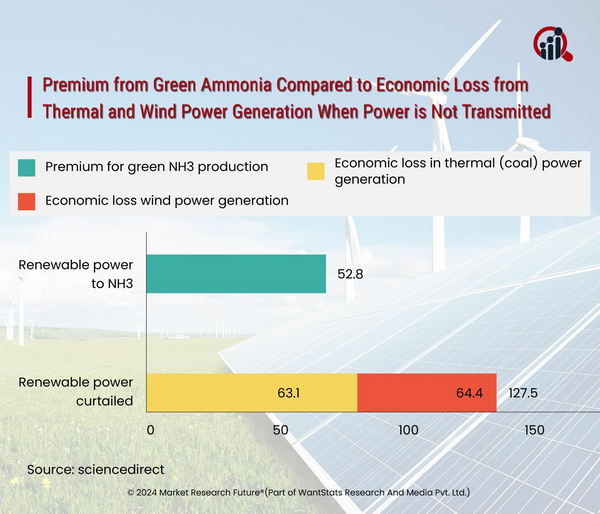
Green ammonia is gaining momentum in the energy market of 2024. This is due to the increasing demand for renewables in light of the clean energy transition. Green ammonia tends to be an effective renewable source in the energy market. Hence, research in 2024 is going on about green ammonia's adaptability in a commercial way.
A surge in the demand of renewable sources accelerates the progress of clean energy transition in the market. Countries worldwide are investing in research to support the production of green ammonia. It is due to green ammonia's role in decarbonization. Green ammonia accelerates the decarbonization process in industries where reducing carbon emissions is difficult. Therefore, researchers are developing green ammonia…
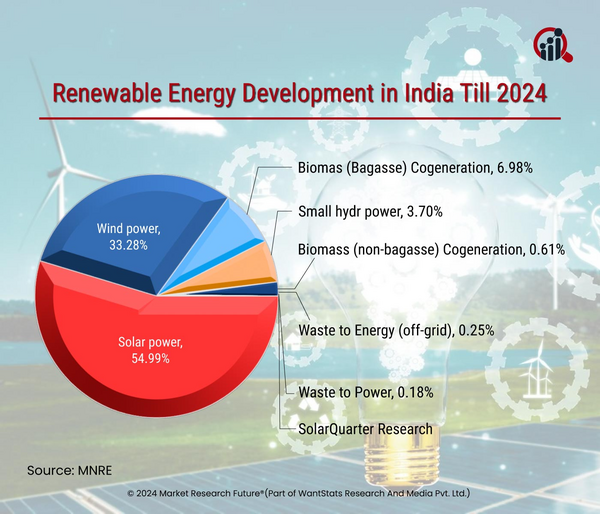
The clean energy transition is growing rapidly in different nations to reduce carbon emissions. Globally, countries are taking various initiatives in 2024 to achieve net zero emissions by the end of 2050. Asian countries are increasing their green energy sources to fulfill the demands of clean fuel, electricity, and other energy sources in 2024. Simultaneously, the climatic changes in India will affect the energy sector in 2024. The heatwaves throughout India led to a surge in power demand that records for all time.
According to surveys in 2024, extreme heatwaves in India hindered the power supply due to soaring demands. This is due to various climatic factors, such as climatic changes, El Nio, population growth, transportation, and…
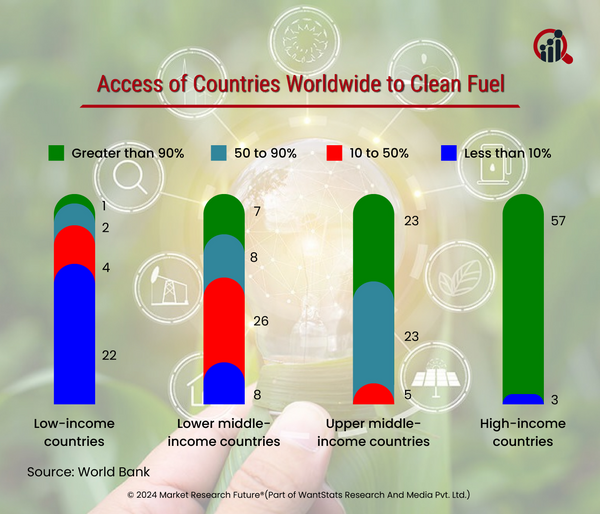
Clean fuels are the new elements in green energy transformation. It is gaining momentum with the potential of limiting harmful greenhouse gas emissions. However, surveys in 2024 state that adopting clean fuels for domestic usage is a long process.
The energy market is enhancing renewables' processes and production levels to produce clean energy. However, large-scale production of clean fuel is an important aspect of meeting the countries' domestic demand. For emerging Asian countries like India and China, it is challenging to meet the domestic demand for clean fuels. Moreover, clean fuels tend to be more costly than fossil fuels . The reason behind the cost factor of clean fuels emerges from the fuel production infrastructure. Clean fuels…

A growing dependency on Internet marketing has led to several disruptions in the web sector. The number of botnets will increase in the internet sector in 2024. Numerous botnet activities in 2024 are an indication of Internet security. The active botnet cases show that multiple IP addresses are compromised and fall victim to it. The botnet is a simple description that suggests an attacker can control a network of computers, which can lead to unethical and dangerous activities. The compromised network of computers gets affected by the attacker that controls the system remotely by injecting various malware. Several modes of communication, like computers, smartphones, and others, have become the medium of botnets.
In 2024, several…
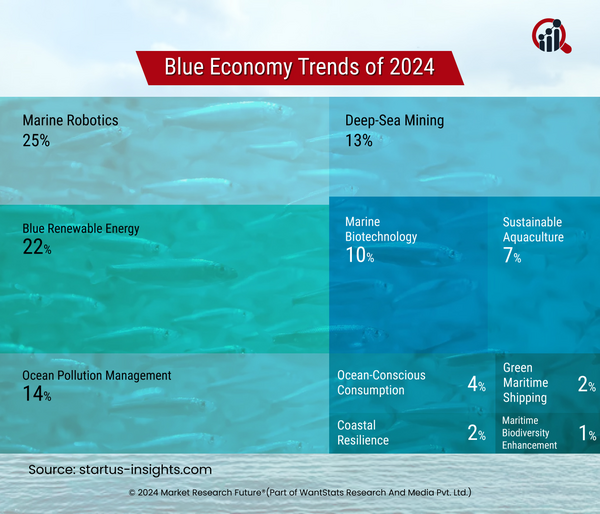
The clean energy transition gives rise to many sustainable solutions for developing a sustainable economy in 2024. Globally, nations emphasize the blue economy to improve the clean energy transition. The environmental transformation focuses on the shift from fossil fuels to renewables. Hence, the blue economy serves as an effective platform to accelerate fossil fuel production in 2024.
European Union's blue economy report 2024 focuses on developing coastal frameworks, marine infrastructure, and other technological innovations. The survey suggests balancing technology and consumers' sustainable habits for a blue economy. However, fossil fuel dependency may appear to be a hurdle. It can be easily overcome by the faster production of…
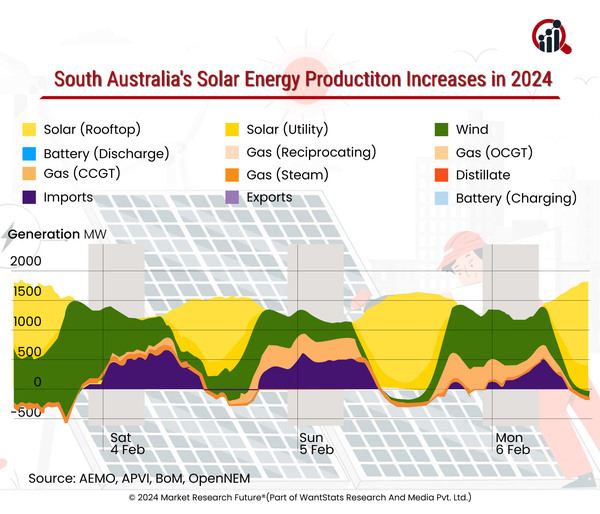
Countries worldwide are progressing in clean energy transition with the help of renewables. Wind and solar sources of renewable energies are essential aspects of enhancing the energy market in different world economies. A survey shows South Australia will adopt solar power to improve its economic conditions in 2024.
According to the progress of the energy market in Australia, the country is developing wind and solar energy resources. Australia is investing in large-scale solar and wind energy production in 2024. The nation aims to achieve 100 percent renewable production by 2030. Moreover, Australia's current renewables production rate is 68 percent, as noted in 2022. With the progress in clean energy transition in 2024, Australia …

Big techs play a major role in the clean energy transition in 2024. Since the beginning of the transformation process, big tech companies are investing in renewables to support net zero emissions by the end of 2050. Some companies from the big techs group aim to achieve the clean energy transition by 2030. However, it depends solely on the company's work procedure that decides the dependency on renewables. Experts claim that artificial intelligence can facilitate the clean energy transition. Artificial intelligence can increase work efficiency and optimize the processes included. AI can predict renewable sources to enhance power grid management as well. However, a survey in 2024 suggests that artificial intelligence can lead to the downfall…
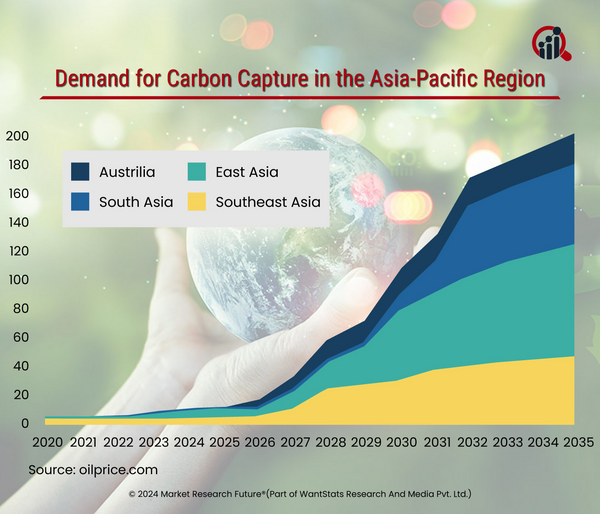
Carbon storage or carbon sequestration process is a new phenomenon developed by nations to enhance clean energy transition. This process incorporates capturing carbon emissions from different sources in the environment. Hence, environmental carbon capture can efficiently reduce the emissions rate from transportation, industries, and others to tackle climate change conditions. Research on carbon storage shows that Asia-Pacific is the emerging region in carbon capture and storage in 2024. Carbon storage is an effective way to mitigate climate change. Therefore, several nations in the Asia-Pacific region are moving fast with carbon capture method in 2024.
According to the survey conducted in 2024, countries like Indonesia, Malaysia, and…
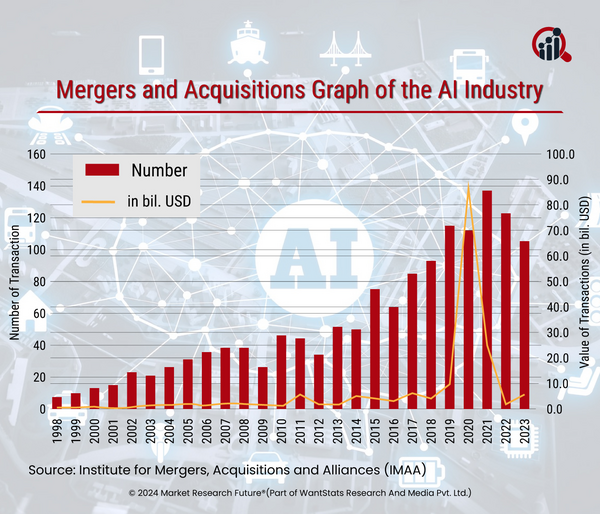
Artificial intelligence influences the demand for renewable energy sources in 2024. Renewables demand is increasing daily due to the transition to clean energy. Researchers claim that the surge in artificial intelligence gives new space for the growth of mergers and acquisitions (M&A) in the clean energy domain. The survey in the clean energy sector claims that the growth of artificial intelligence will increase the demand for renewables in 2024.
In the era of artificial intelligence, there is a growing affinity towards renewable energy sources. This is due to the need for huge power backups to support data centers in functioning with the help of artificial intelligence. The functioning of artificial intelligence requires a large amount of…
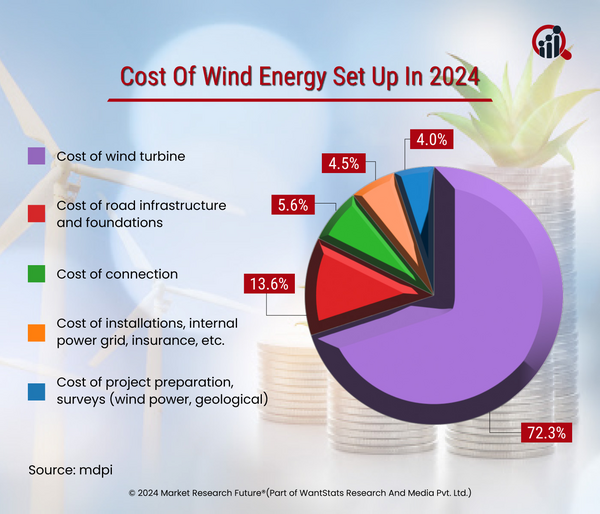
Renewable energy expansion is growing at a rapid rate in 2024. This is due to the increasing affinity of the energy market with renewable sources in the light of green energy transformation. Wind and solar energy sources are among the most widely produced renewables in the energy market of 2024. It is due to the wide availability of solar and wind energies. China surpasses other nations in shaping its solar and wind energy status globally. China set up its standard high with the wide range of production of solar panels in the world. Similarly, wind energy will contribute to the production of electricity in 2024. However, wind energy faces challenges in nations other than China due to constricted onshore wind markets in 2024.
According to…
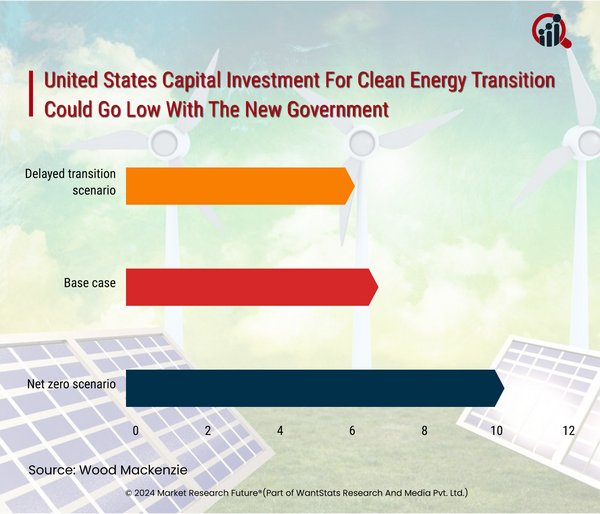
The clean energy transition is gaining momentum in the energy market globally. The compelling cause of the transition is climatic change due to the harmful emissions from different sources. Therefore, it is vital to incorporate renewables in the production of energy. Nations worldwide are tactfully utilizing renewables to get better, greener outcomes. To be precise, the energy market is currently overwhelming with renewables. Developed countries like the United States are in the race for clean energy transition at a faster pace. However, experts cite that the next new government in the United States may affect this transformation financially. Regarding market trends, the transition to renewables requires heavy funding, and it is expected to…
In the changing era of clean energy, nations are taking many initiatives globally. The steps taken to support clean energy transition would result in positive results for climatic changes. Semiconductors are a part of the clean energy revolution by playing a pivotal role in the electronics' mechanism. Experts believe that semiconductors play a significant role in transforming clean energy by empowering renewables. Studies have proven that the semiconductors market will grow by 14 percent annually in 2024. Semiconductor's market is expected to experience a strong rebound in 2024.
Enabling renewables for green energy transformation would help enhance the microchips in electronics. However, semiconductor manufacturing has its demerits as it…

According to the experts' analysis in 2024, Nvidia's earnings…

Electric vehicles are a game changer for the clean energy transition. Electric vehicles (EVs) are the significant ones in reducing the emissions from the transportation sector. Therefore, the growing affinity towards electric vehicles in developed and emerging nations is a big deal. While China's EV production grows daily, EV sales are dropping in Western countries. Hence, the global downturn in electric vehicle sales is a concern in 2024. The energy market anticipates the reduction of carbon emissions compared to conventional vehicles by opting for electric vehicles. To achieve clean energy ambitions by 2050, transportation must contribute toward it with electrification by 70 percent in the next fifteen years. However, the global economic…
Business News
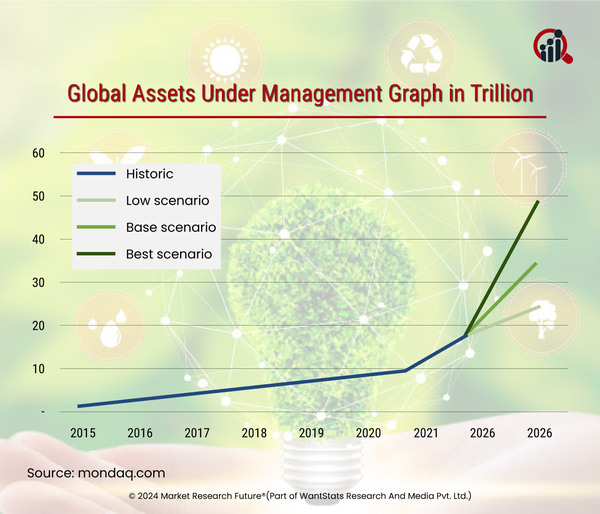
London Emerges as Global Leader in Sustainable Finance for Green Transition
Sustainability demands a constant flow of finances in the energy market for the clean energy transition . In the era of…
Read more →

Countries Investing on Green Ammonia’s Production to Support Clean Energy Transition
Green ammonia is gaining momentum in the energy market of 2024. This is due to the increasing demand for renewables in…

India’s Power Demand Surges Due to Increasing Heatwaves
The clean energy transition is growing rapidly in different nations to reduce carbon emissions. Globally, countries are…

Clean Fuels Requires More Development for Domestication
Clean fuels are the new elements in green energy transformation. It is gaining momentum with the potential of limiting…

Free Cloud Setups are a Victim of Botnets Increasingly
A growing dependency on Internet marketing has led to several disruptions in the web sector. The number of botnets will…

Blue Economy Helps in Electricity Production in 2024
The clean energy transition gives rise to many sustainable solutions for developing a sustainable economy in 2024…

South Australia Increases Adoption of Solar Energy in 2024
Countries worldwide are progressing in clean energy transition with the help of renewables. Wind and solar sources of …

AI Affects Big Tech’s Efforts Towards Clean Energy Transition
Big techs play a major role in the clean energy transition in 2024. Since the beginning of the transformation process…

Asia-Pacific Emerges as the Leading Nation in Carbon Capture
Carbon storage or carbon sequestration process is a new phenomenon developed by nations to enhance clean energy…

Increasing Demand of Artificial Intelligence Influences M&A Opportunities in the Market
Artificial intelligence influences the demand for renewable energy sources in 2024. Renewables demand is increasing…

Wind Energy To Generate Profits In The Energy Market
Renewable energy expansion is growing at a rapid rate in 2024. This is due to the increasing affinity of the energy…

Next Government In U.S. May Affect Clean Energy Transition
The clean energy transition is gaining momentum in the energy market globally. The compelling cause of the transition is…
Semiconductors Possess Threat To The Environment
In the changing era of clean energy, nations are taking many initiatives globally. The steps taken to support clean…

Nvidia Outperforms In Earnings With Data Centers In The First Quarter Of 2024
Data centers will be gradually shaping their position in the industry in 2024. This is due to the increasing use of…

Drop in Electric Vehicles Sales May Affect Automotive Economy of China
Electric vehicles are a game changer for the clean energy transition. Electric vehicles (EVs) are the significant ones…

© 2024 Market Research Future ® (Part of WantStats Reasearch And Media Pvt. Ltd.)
HOME Research Insight Siemens Healthineers, (Germany) and Philips Healthcare (Netherlands) are Leading Players in the Digital Radiography Market
Siemens healthineers, (germany) and philips healthcare (netherlands) are leading players in the digital radiography market.
- DOWNLOAD PDF
The global digital radiography market size is projected to grow to USD 1.9 billion by 2029 from USD 1.6 billion in 2024, at a CAGR of 3.5% during 2024-2029. A few drivers of the digital radiography market are as follows: Improving performance and capabilities of digital radiography systems with the need for technological advancements, which has resulted in better image quality, faster processing time, and reduced radiation exposure.
The market for digital radiography does not seem to be very fragmented; however, until now, it has been showing quite a number of well-established companies and upcoming rivals in the race to share the same marketplace. The key players operating in the global digital radiography market include Siemens Healthineers, (Germany), Philips Healthcare (Netherlands), GE Healthcare (US), Canon, Inc (Japan), Shimadzu Corporation (Japan), Agfa-Gevaert Group (Belgium), Samsung Medison (South Korea), Konica Minolta (Japan), Shenzhen Mindray Bio-Medical Electronics Co., (China), FUJIFILM Holdings Corporation (Japan), among many others.
To know about the assumptions considered for the study download the pdf brochure
The top players in the digital radiography market utilize some of the key strategies that help them stay ahead in the competition. Continuing research and development allows companies to come up with new, innovative, and technologically advanced digital radiography systems and improve their product lineups. Strategic partnerships and collaborations with healthcare providers and institutions are also done to get greater market share and increase their reach. The key players focus on customer-oriented strategies that involve a full range of training, support, and maintenance services to enhance user experience and satisfaction. Siemens Healthineers, (Germany), accounted for the leading position in the Digital radiography market in the year 2023, followed by Philips Healthcare, Netherlands, GE Healthcare, (US), Canon, Inc., (Japan), and FUJIFILM Holdings Corporation, (Japan).
SIEMENS HEALTHINEERS (GERMANY)
Siemens Healthineers is one of the global leaders in medical technologies, including digital radiography systems. Their digital radiography systems unite ultra-modern technologies with sophisticated imaging possibilities for generating first-class diagnostic images while keeping a sharp eye on patient safety and comfort. Siemens Healthineers' digital radiography systems provide healthcare facilities with as much diversity in requirements as possible. Equipped with versatile configurations, the systems accommodate a wide range of clinical applications, from routine diagnostic imaging to specialized procedures. These machines are equipped with user-friendly graphical interfaces and workflow optimization tools, enabling the whole process of imaging to be streamlined for healthcare professionals to effectively acquire and interpret images. Siemens Healthineers is working relentlessly to evolve this digital radiography technology, focusing on innovation and continuous improvement. With modern challenges and demands shifting in healthcare, every effort combines to make patients better and to deliver advanced services in diagnostic imaging worldwide.
PHILIPS HEALTHCARE. (NETHERLANDS)
Philips is among the top four players in the digital radiography market. The company believes in research & development activities to maintain its leading position in the | digital radiography market. The company spends over 10% of its annual turnover on R&D activities and product development that has helped the company to launch innovative products continuously in the market. For instance, CombiDiagnost R90, Digital Diagnost C90, and ProxiDiagnost N90 are some of the products launched by the company in the last three years. The company also focuses on teleradiology services and has launched SHINEFLY in collaboration with Digital China Health of China for the Chinese market. Philips also follows inorganic growth strategies in the form of partnerships, collaborations, and acquisitions. The strong product portfolio of the company, its geographical presence, and ongoing partnerships and agreements are well complemented by frequent launches, which have further strengthened this position in the market.
GE HEALTHCARE (US)
GE Healthcare is one of the major medical technology businesses that provide a complete and innovative digital radiography system portfolio, standing for reliability and performance. These innovative digital radiography systems from GE Healthcare use advanced technology to provide high image quality to clinicians for accurate diagnosis and patient care. These products are designed for all healthcare environments-small clinics and large hospitals alike—the strengths of which must be needed at each step in terms of versatility and flexibility. Digital radiography from GE Healthcare drives workflow efficiency and user experience by hosting sophisticated image processing algorithms, integrated intuitive user interfaces, and ergonomic designs. With very strong commitments to research and development, it would never be at par in upgrading digital radiography systems with new technologies so as to quickly respond to new arising challenges in clinical care.
Related Reports:
Digital Radiography Market by Product (Fixed (Floor-to-Ceiling, Ceiling), Portable (Mobile, Handheld)), Type (Retrofit, New Digital System), Application (Chest, CVS, Ortho, Pediatric), End User (Hospitals, Imaging Center) - Global Forecast to 2029
Contact: Mr. Rohan Salgarkar MarketsandMarkets™ INC. 630 Dundee Road Suite 430 Northbrook, IL 60062 USA : 1-888-600-6441 [email protected]

This FREE sample includes market data points, ranging from trend analyses to market estimates & forecasts. See for yourself.

- Press Releases
- Case Studies
- Competitive Leadership
- Engage Forums
- Flyers & Brochures
- Infographics
- Perspectives
- Testimonials
- Board Of Directors
- Leadership Team
- Research Experts
- Photo Gallery

- REQUEST FREE SAMPLE REPORT
- +1-888-600-6441 (Corporate office hours)
- +1-888-600-6441 (US/Can toll free)
- +44-800-368-9399 (UK office hours)

- Top Market Reports
- Conferences
- New Reports
- Research Insight
- Privacy Policy
- Terms and Conditions
- ©2024 MarketsandMarkets Research Private Ltd. All rights reserved


IMAGES
VIDEO
COMMENTS
Market Research Future is one of the leading market analysis companies. We provide global market research reports, market share analysis, market research industry future. Our mission is to help businesses thrive in the fast-paced evolving marketplace and maximize their profits.
Workplace Market Research Future (MRFR) is a global market research company that takes pride in its services, offering a complete and accurate analysis with regard to diverse markets and consumers worldwide. MRFR's approach combines the proprietary information with various data sources to give an extensive understanding to the client about the latest key developments, expected events and ...
Market Research Future's (MRFR) Chief Executive Officer and Founder Vinit Ketan boasts of over 15 years of expertise as a seasoned business owner in the field of market research. He is dedicated to delivering clients with high-quality, useful research and has a thorough awareness of the market research ecosystem.
Market Research Future is a legitimate company providing credible market information in its reports. MRFR is certified by the European Society for Opinion and Marketing Research (ESOMAR). MRFR procures data from purchased databases, SME journals, and pertinent databases from third-party vendors. About 80% of their research is based on primary data.
Market Research Future® (MRFR) | 20,521 followers on LinkedIn. We Enable Our Customers to Unravel the Complexity | Market Research Future (MRFR) is one of the most trusted firms for syndicated research services. Our name has been synonymous with qualitative research from the get-go and the go-to place for accurate and impactful market analysis. Our dedicated team of analysts, subject matter ...
Market Research Future® (Part of WantStats Research And Media Pvt. Ltd.) offers premium progressive statistical surveying, market research reports, analysis ...
Future Market Insights, Inc. is a top market research firm headquartered in Newark, Delaware - United States. Explore Future Market Insights' 15,000+ market research reports and business intelligence. Research and consulting partner to 80% of Fortune 1,000 companies. Login .
Market Research Future has an overall rating of 3.7 out of 5, based on over 114 reviews left anonymously by employees. 70% of employees would recommend working at Market Research Future to a friend and 83% have a positive outlook for the business. This rating has improved by 7% over the last 12 months.
Market Research Future's reports exhibit a distinct focus on products, services, technologies, applications, end users, and market players, encompassing global, regional, and country-level market segments. This tailored approach equips clients with a comprehensive view that empowers them to gain deeper insights, expand their knowledge, and take ...
Market research software: Crunchbase is a platform that provides best-in-class company data, making it valuable for market research on growing companies and industries. You can use Crunchbase to access trusted, first-party funding data, revenue data, news and firmographics, enabling you to monitor industry trends and understand customer needs. ...
Market Forecast - Exciting Growth Ahead. According to BCC Research, the global market for microelectronic medical implants will soar from $49.0 billion in 2024 to an impressive $85.1 billion by 2029! This represents a remarkable CAGR of 11.7% over the forecast period (2024-2029).
Market Research Publications | Market Research Future. [email protected] 📞 +1 (855) 661-4441 (US) 📞 +44 1720 412 167 (UK)
The future of market research is shaped by several key trends, including the adoption of Predictive Analytics and Artificial Intelligence (AI) for more precise predictions and personalized insights. Customer-centric approaches, driven by direct customer feedback and enhanced user experiences, are also at the forefront. ...
The global market research industry generates over $118 billion in annual revenue and the United States holds a 53% share of this market. Reflecting on the beginning of the year and the various predictions about crucial trends in market research for 2024, several companies, including Resonio, ReconMR, and TechCrunch, anticipated that artificial intelligence would be a major game-changer.
Grand View Research provides off the shelf, syndicated market research studies, publishing over 240 reports each year, covering 45 industries, on a global as well as regional level. We track various industries, identifying key markets and understanding key macro and micro-economic trends. Keeping pace with the business environment, we publish ...
Crawford argues market research is essentially future-focused, an observation that rings true for all practitioners. Market researchers collect data so their clients can anticipate the future, form policy and plan accordingly. Advertising, a reason for much research going back over the years, is perhaps even more future-focused and at times ...
Longitudinal tracking. One of the biggest market research trends going into 2023 and beyond will be longitudinal studies and tracking. For far too long, research has relied on broken-down respondent sets that do not help gather a macro-level view of data and insights. With the help of community management platforms, longitudinal research helps ...
Market research enables businesses to: 1. Better comprehend their target audience's demographics and segment customers effectively. 2. Study competition and recognize market trends. 3. Guide ...
The future of market research. 20 October 2022. Authors Eric Duchamp. From researcher to business partner: A new mindset for market researchers to elevate their value proposition. Business Trends.
Data Analytics Market Overview. Data Analytics Market Size was valued at USD 55.1 billion in 2022. The Data Analytics market industry is projected to grow from USD 7.03 Billion in 2023 to USD 303.4 billion by 2030, exhibiting a compound annual growth rate (CAGR) of 27.60% during the forecast period (2023 - 2030).
Making Market Research Easy - Enhancing Industry Partnerships This webinar is free and open to all of industry. Join the GSA Office of Small and Disadvantaged Business Utilization and the GSA Federal Acquisition Service Office of Customer & Stakeholder Engagement (CASE) as they team to provide innovative insights on how to respond to GSA's RFIs.
Source: HFS Research, 2024. Retailers with this rudimentary mindset have been experiencing significant customer churn (up to 30%), a continuous dip in market share (3-5% per year), and cost overruns of more than 20% because of operational inefficiency. ... The HFS 'Future of Retail' framework (see Exhibit 2) has two intertwined layers. The ...
North Carolina's population is also aging. Between 2020 and 2023, the state's senior population grew by 11.2%, outpacing the total (3.8%), preschool age (1.1%), school age (0.5%) and working-age (2.9%) population growth rates (see Figure 4). 6 This demographic shift, coupled with normal age-related mortality, deaths of despair among prime working-age males, and declining male college ...
Bluefield Research anticipates strong demand for digital water solutions in North America, underpinning a cumulative US$169.5 billion in spending from 2024 to 2033. ... demand intensifies, from very large to very small utilities, the vendor landscape is becoming more competitive. The market is currently dominated by established water technology ...
marketresearchfuture - Industries. [email protected] 📞 +1 (855) 661-4441 (US) 📞 +44 1720 412 167 (UK)
Stigma is a discrediting attribute that emerges in social interactions, playing different roles in different contexts. Several fields (e.g., sociology and psychology) have dedicated special attention to this phenomenon as it significantly impacts people's lives. Although there is some interest in the idiosyncrasies of stigma in marketing and consumer behavior, the literature investigating such ...
Latest Business News | Market Research Future. [email protected] 📞 +1 (855) 661-4441 (US) 📞 +44 1720 412 167 (UK) Free Cloud Setups are a Victim of Botnets Increasingly. By Shubhendra Anand, 22 August, 2024. A growing dependency on Internet marketing has led to several disruptions in the web sector.
The research insight on digital radiography market highlights the growth strategies of the companies. Know the future scenario, forecast, and current trends in digital radiography. Siemens Healthineers, (Germany) and Philips Healthcare (Netherlands) are Leading Players in the Digital Radiography Market